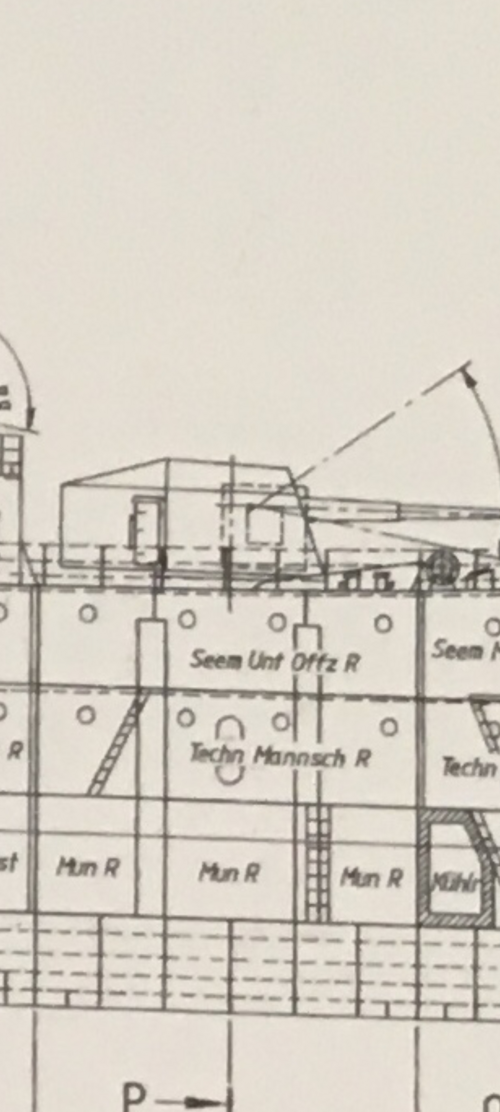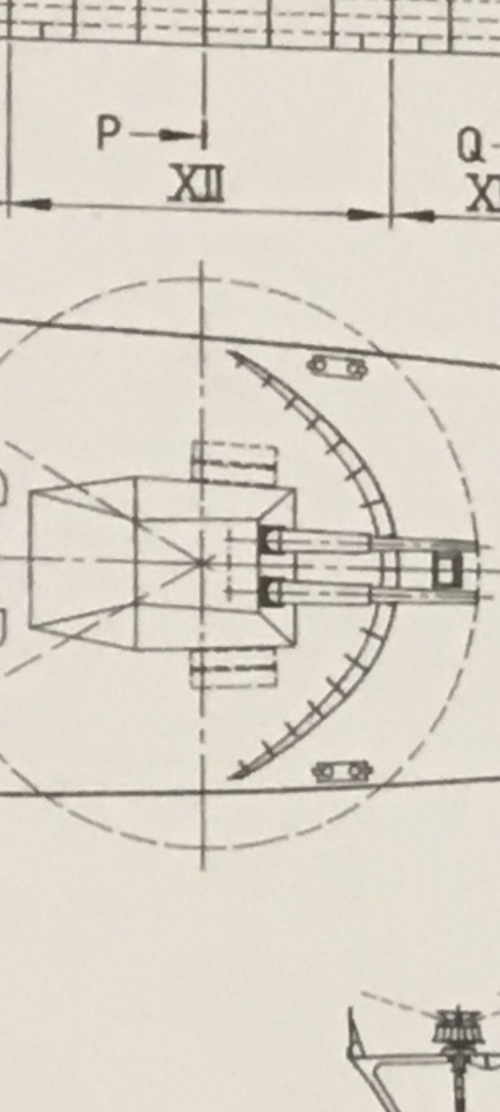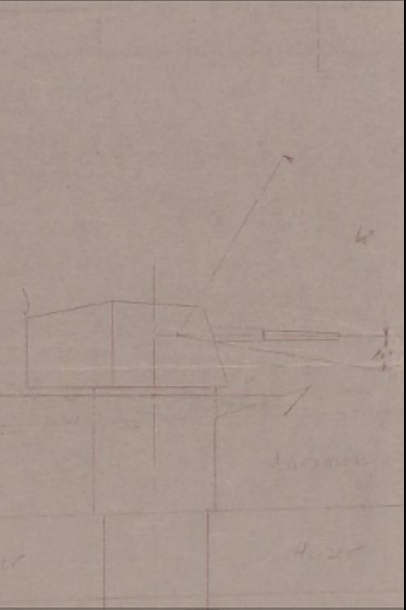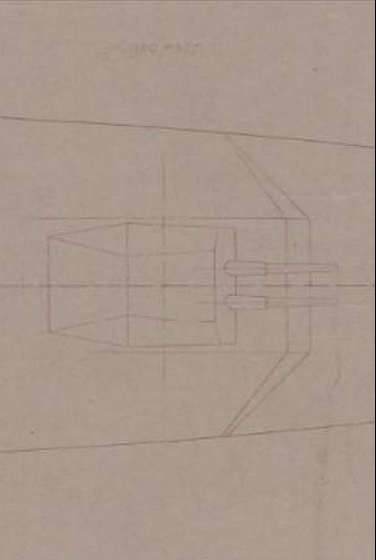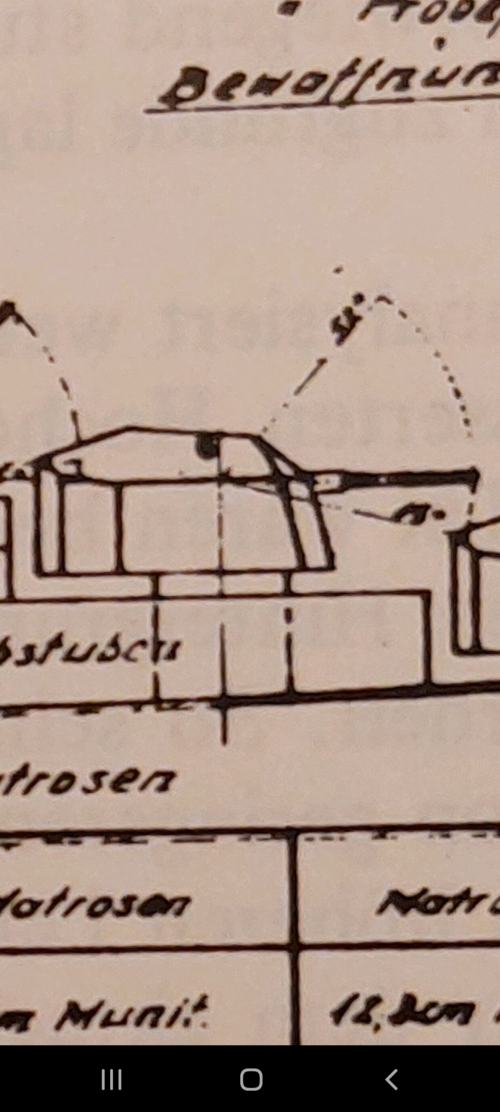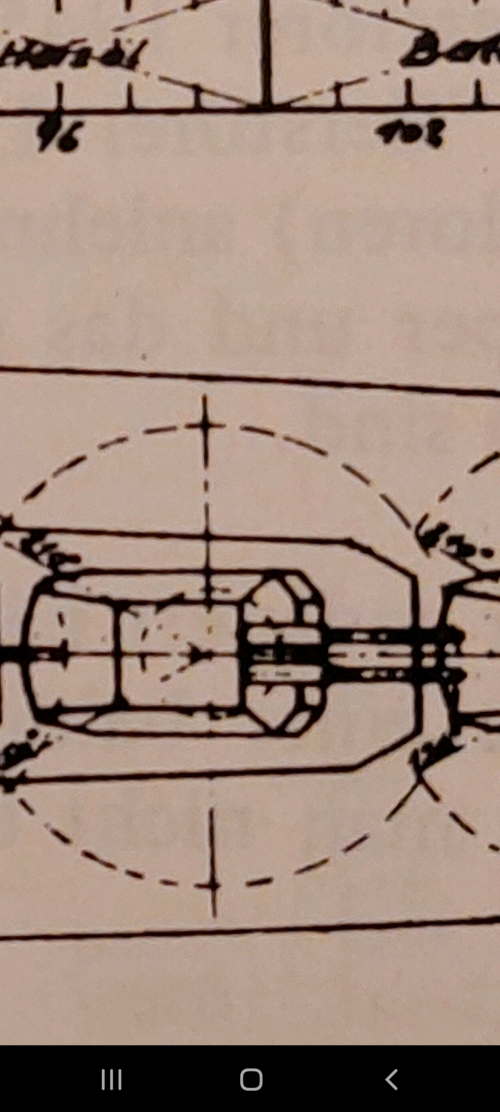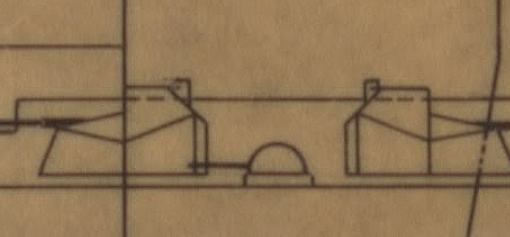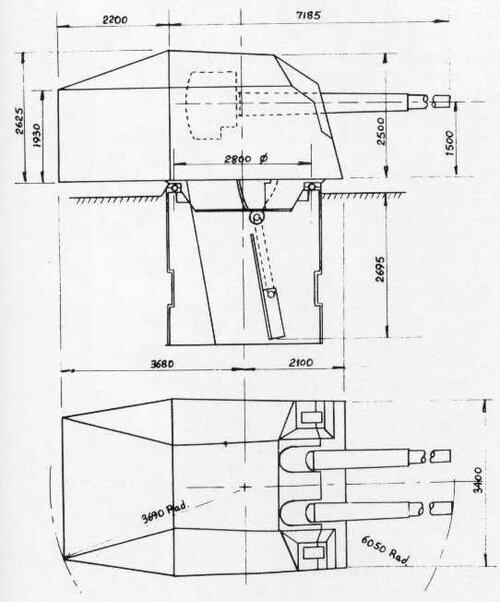You are using an out of date browser. It may not display this or other websites correctly.
You should upgrade or use an alternative browser.
You should upgrade or use an alternative browser.
Kriegsmarine - KM Naval Armament Plans/Discussion
- Thread starter _Sarcasticat_
- Start date
_Sarcasticat_
Die Katze.
- Joined
- 16 April 2020
- Messages
- 364
- Reaction score
- 351
I'd love to do that, when I can find the motivation to do so.Now with the 40.6cm breech provided, i think we can start to remeasuring barrel length more properly now, starting from the barrel tip to the trunnion, since most these plans only scale with full barrel.
_Sarcasticat_
Die Katze.
- Joined
- 16 April 2020
- Messages
- 364
- Reaction score
- 351
Alright everyone, I've transferred just about anything of importance from The Dreadnought Project.
I'll be moving things I've found from other threads regarding 3.7cm and 3cm guns over to here, as the discussions there are valuable in and of themselves.
I still need to move the RM 25 folder contents to their new homes, I suspect I will be doing this in chunks over time. They will also be renamed so identifying the plan is easier.
I'll be moving things I've found from other threads regarding 3.7cm and 3cm guns over to here, as the discussions there are valuable in and of themselves.
I still need to move the RM 25 folder contents to their new homes, I suspect I will be doing this in chunks over time. They will also be renamed so identifying the plan is easier.
_Sarcasticat_
Die Katze.
- Joined
- 16 April 2020
- Messages
- 364
- Reaction score
- 351
Okay, here's the 3/3.7cm stuff.















Here you can see USS T-35 (DD-935), postwar and in US hands. On flying bridge wings you can see what somewhat obviously are 3.7cm/57 M43 in Einelafette port and starboard. Here is an additional picture of the M43 single in LM43.

The LM43 appears to be, or be strongly based off of, the single Heer/Luftwaffe mount while the LM44 twin is a modified Doppellafette LM42 from the 3.7cm M42.



Bottom two images show the 3cm twin mounts intended for Flottentorpedoboot 1944. Sources are weird for these guns, so I wouldn't say that they're the 3cm MK 3O3 Brunn guns. Die Deutschen Flottentorpedoboote 1942-1945 states these are "3-cm-Flak M 44 L/44 in funf Doppellafetten M 44"...meaning these would be...3cm MK 103's? Die Deutsche Kriegsmarine 1935-1945 Band 7 - Die Entwicklungsgeschichte der Zerstorer und Torpedoboot says they are "3-cm-Flak L/44,6 M-44 in Doppellafetten LM-44" which is without a doubt aiming for the 3cm MK 103. Still, it makes me wonder if there was a mixup between the MK 103 and the Mauser 3cm M44 design.
Some extra on MK 411, for the curious:

Still hoping that one day I will get that dump of information on the 3cm/44 MK 103 so I can add it in further detail to this list.
3,7CM FLAK SK C/36:
37 × 250R AMMUNITION.
This almost unknown gun was the Kriegsmarine’s first attempt to acquire an automatic 37mm AA cannon. Instead of using the 37 × 264B Flak ammunition (as used in the Flak 18, Flak 36, Flak 37 and Flak M43), Rheinmetall-Borsig designed the gun around a version of the Army 37mm cartridge used in manually-loaded tank and anti-tank guns. This rimmed cartridge case was modified by giving it a thicker rim, presumably to strengthen it in view of the more violent extraction forces in an automatic mechanism. The HE shells it fired were the same as those used in the Flak 18+ ammunition.
The gun bore a close resemblance to the Bofors guns, including the boxy receiver and a gravity feed above the mechanism taking 5-round clips, and was presumably based on these. It was fitted to a C/36 single mounting. Few technical details are available, beyond a gun weight of 240kg (930–1,040kg including the three-axis mounting) and a rate of fire of up to 180rpm.
It seems that not many C/36 were made, being deployed on only a few vessels, according to a Handbuch für Admiralstabsoffiziere which lists the Aviso Hela, the two Type 1A submarines U-25 and U-26 (and possibly some Type IX), torpedo boats and fishing protection vessels.
The Kriegsmarine had another try some years later, resulting in the 3,7cm M42 (see below) which used the same ammunition and general design, retaining the boxy receiver and the vertical gravity feed. It is evident that the M42 was an improved SK C/36, and the first mount- ing used by the M42 was the C/36.
Confusion over the German 37mm naval AA guns and their designations is widespread, and not only over whether the C/36 term is being used to describe the gun or the mounting (if the latter, the gun could be either the SK C/36 or the M42, as they are hard to tell apart). Also, it is often stated that the SK C/36 is nothing more than a marine version of the Luftwaffe’s Flak 36, when the two guns are completely different in their design as well as in the ammunition they fired. The situation is even more confused as some Flak 18/36/37 guns were indeed fitted to ships as a quick way of boosting their AA defences, so alertness is necessary in determining which guns are actually being referred to.
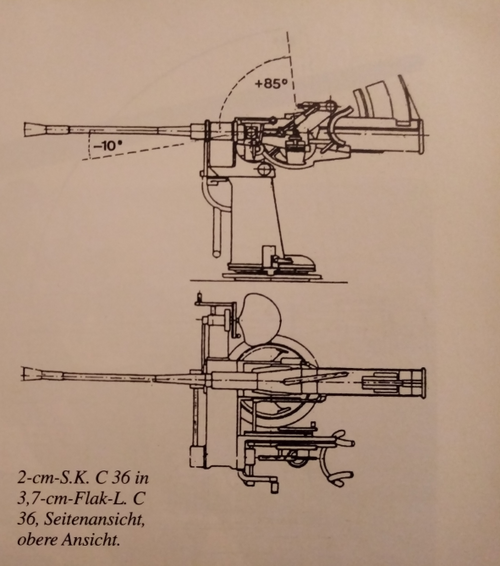
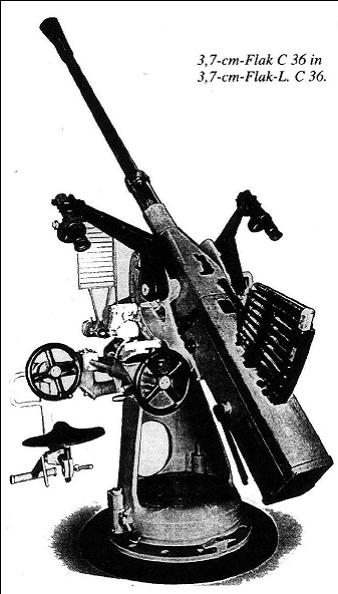
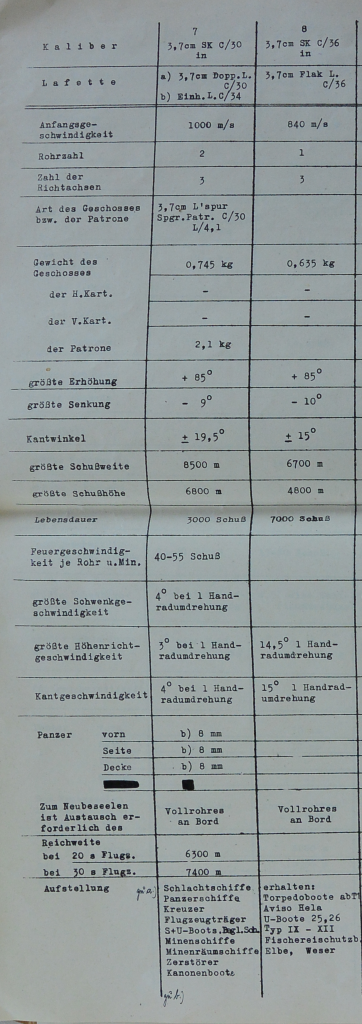
Sticking to the "Handbuch für Admiralstabsoffiziere", my best guess is that the triaxial 3,7 cm Flak L. C/36 mount was never mounted in the intend receivers (aviso Hela, fishery protection boats, torpedo boats, Type I , IX and XII U-boats, Elbe, Weser) and, by memory, most of them having just the older C/30 double mount (besides the never built Type XII). About the gun, again, in my opinion it is already depicted in posts #7 and #17, being a naval Flak 36. This is as far as my knowledge and guessing goes.
3,7CM FLAK 18, 36, 37; M36; BK
3,7: 37 × 264B AMMUNITION.
This series formed the bulk of the Luftwaffe’s medium-calibre automatic AA guns for the duration of World War II. The prototype of this series was designated the Rheinmetall ST 10, which was nominally handed over to Solothurn for further development as the S10-100, before being formally returned to Rheinmetall-Borsig. The mechanism used a short-recoil rotating-head lock with the cocking handle, attached to the front of the bolt, riding in a long slot in the receiver, which curved sharply as it approached the forward end of its movement, rotating the bolt head locking lugs.
The guns in this series were basically the same, with L/57 barrels, weighing 278–295kg and firing at 160rpm. The differences between the Flak 18, 36 and 37 mainly involving the mountings and sights: the Flak 18 had a cumbersome four-wheel mounting and was only made in small numbers, from around 1935, before being replaced by the Flak 36 which had a much improved two- wheel mounting. The Flak 37 differed in being fitted with a new sight, the Flakvisier 37, which incorporated a computer with a clockwork drive. Mounting weight in action varied from 1,550 to 1,750kg.
The BK 3,7cm was adapted to be carried by aircraft, primarily in the anti-tank role.
Images of 3.7cm Flak 18/36 guns onboard ships (ZG3 Hermes first picture, Romanian ships for the last three images).37 × 264B FLAK 18
This was the standard German land- based medium automatic AA gun ammunition of World War II, being used in a succession of weapons designated Flak 18, 36, 37 and the M43 which was also used in a naval mounting. It was also used in a modified version of the Flak 18, the BK 3,7 aircraft gun used for ground attack.
The cartridge case is tapered and belted, typical of Rheinmetall-Borsig automatic cannon ammunition of the period. It contained 189g propellant which generated 255Mpa chamber pressure. The complete round is 367mm long and weighs about 1.5kg. Projectiles had two copper driving bands until 1940 when a shortage of copper led to the use of a single soft-iron band instead, which required the gun chamber to be slightly shortened. The usual loadings were:
• HE: 635–644g nose-fuzed shell, with or without added incendiary element or tracer; HEI-T contained 24g HEI; SD (self destruct) impact fuze; MV 820m/s; 6.5 s tracer burn
• AP-T: 680–700g base-fuzed shell; 790m/s; 2 s tracer burn; penetration 50mm/90 degrees/500m, 40mm/60 degrees/500m
• APCR: (H-Panzergranate for the BK 3,7 only); 380g tungsten-cored shot, MV 1,170m/s; penetration 140mm/ 90°/100m, 70mm/60°/100m.
• In addition, a Minengeschoss was under development: 550g, contained 90g HTA explosive; the tracer burned for 2,000m (4.1 s); SD took place 2,800–3,500m.
Russia acquired technology from Rheinmetall in the early 1930s and developed a multi-purpose automatic cannon around the Flak 18 ammunition: the AKT-37. This failed to enter service.
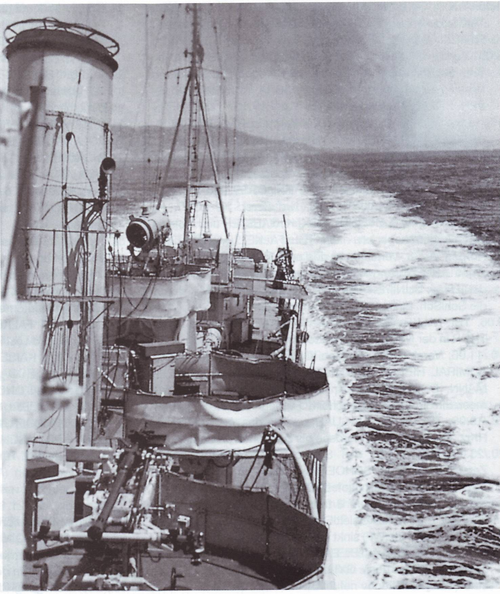
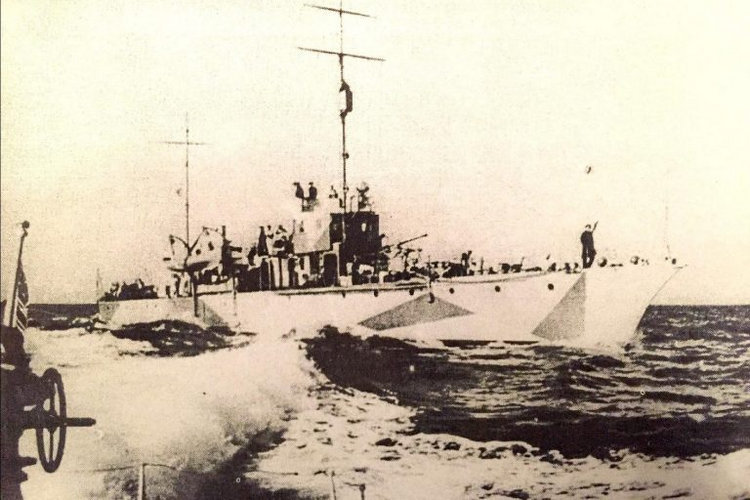
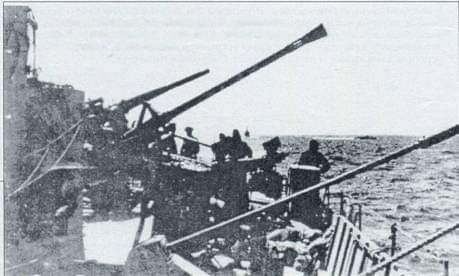
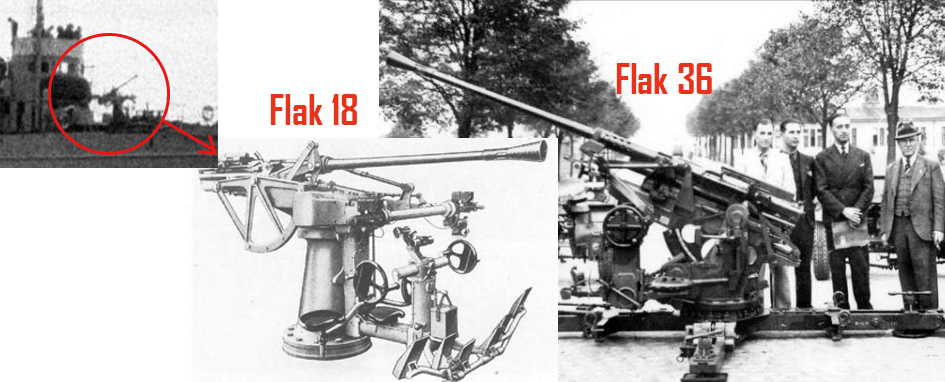
3,7CM FLAK M42: 37 × 250B AMMUNITION.
This Rheinmetall-Borsig design for the Kriegsmarine was a second attempt at an automatic naval 37mm Flak cannon, following-on from the little-used SK C/36 Flak (see above) which bequeathed its ammunition and Bofors-type feed to the M42, 5-round clips being retained. The M42 was evidently closely based on the C/36, otherwise there would seem to have been no point in retaining its unique ammunition instead of using the standard 37 × 264B of the other Flak guns. The performance was similar to the Luftwaffe’s 3,7cm Flak 37 although the mechanism as well as the ammunition differed; the gun was long-recoil operated with an artillery-type wedge lock and continuous feed. An L/69 barrel was used, gun weight was 300kg and the RoF was 160–180rpm.
The original mounting for the M42 was the Flaklafette C/36 (as used by the SK C/36 cannon) but this was soon replaced by the triaxially stabilized LC/39 (also in a U-boat version) and the LM 42 and LM 43, both developed specifically for the gun and weighing 1,350kg. There was a twin mounting, the Doppellafette LM 42 (DLM 42) which weighed 1,750kg. Despite the M42 designation, the gun entered service in late 1943, initially for submarines. An installation programme for fitting this gun to smaller surface ships got underway in 1944.
37 × 250R SK C/36 AND M42
Most German 37mm Flak automatic cannon used in World War II used the 37 × 264B ammunition described below, but two of the naval guns are exceptions. The 37 × 250R cartridge is almost identical to the German army’s 37 × 249R light tank/anti-tank round, only with a slightly thicker rim (3.9mm rather than 2.5mm – presumably to strengthen it in view of the more violent extraction forces in an automatic weapon) and a modified HEI-T projectile. The thick- rimmed round was developed for the naval Flak 3,7cm SK C/36 (cartridge cases with C/36 stamps exist); little is known about this gun, but it appears to have been officially adopted and was installed in a number of second-line vessels. The M42 inherited the same ammunition, but itself saw little use, its successor, the M43, using the standard 37 × 264B round.
The thick-rimmed cartridge case is straight tapered. The HE projectiles were the same as those in the 37 × 264B Flak. The original C/36 loading fired a 625g HE-T shell at an MV of 840m/s. The M42 loadings used 175–185g of propellant generating 290Mpa. There are two crimping grooves locating the projectiles more firmly in the case. This round used the same projectiles as the 37 × 264B except for the APCR. The complete round is 355mm long and weighed 1.37kg when loaded with the standard HEI-T projec- tile, which weighed 644g and was fired at 845m/s. There was also a 680–700g AP loading fired at 815m/s and a 550g Minengeschoss fired at 925m/s, although that last one may not have had time to get into service.
Incidentally, the German navy started the war with a different 37mm Flak gun, the SK C/30, which used very powerful 37 × 380R ammunition, but this was manually loaded so very slow-firing.
I can assure you, with 100% certainty, that the M42 did not use the 37 x 264B ammo.
Below, you can see a photo of a round of 37 x 264B ammo in my collection. Below that, you can see a photo of a disassembled 37 x 250R for the M42. Look at the bases of the two rounds - the M42 has a simple rim, the 37 x 264B has a complex belted design.
Third one down is a page from Waffen-Revue 107, giving technical data on the M42, and finally a close-up of the ammo pic in that document. You can see that the M42 used the ammo with the simple rim, not the belted case.

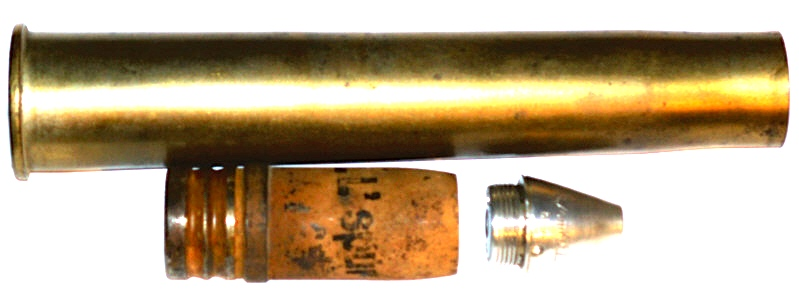
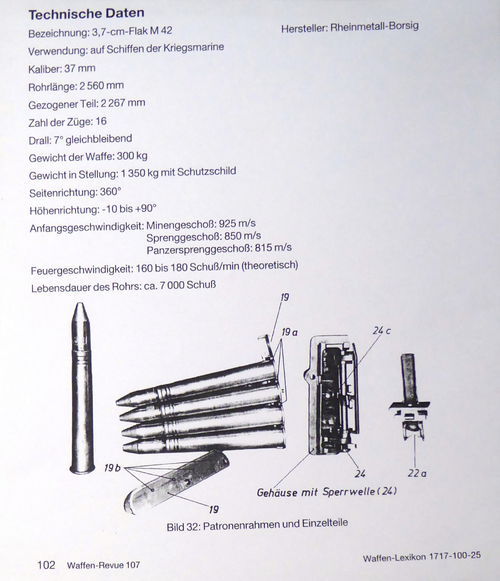
I have checked my references and the two cartridges had very similar performance. The projectiles were the same, and the muzzle velocities were very close. This is surprising because the Flak 36 round looks bigger so should have had room for more propellant, but on the other hand, its barrel is shorter.
3,7CM FLAK 43: 37 × 264B AMMUNITION. ALSO
KNOWN AS GERÄT 339.
This was the final successful attempt at an automatic 37mm Flak cannon, intended for use by both the land forces and the Kriegsmarine. It used the same ammunition as the earlier Flak 18, 36 and 37 series and the same L/57 barrel length, but a new gas-operated mechanism derived from that of the 3 cm MK 103 and featuring a diagonal wedge lock boosted the cyclic rate to 250rpm. Ammunition feed was from the side through enlarged trunnions to minimize the movement of the loading tray and the ammunition came in eight-round strips. Gun weight was 265kg. There were also twin-gun mountings, with the Luftwaffe Flakzwilling 43 mounting one gun above the other, while the Kriegsmarine Flak LM 44 placed them side-by-side.
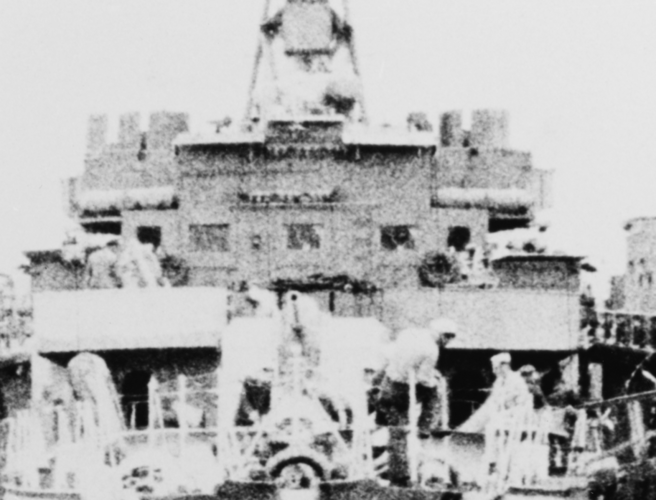
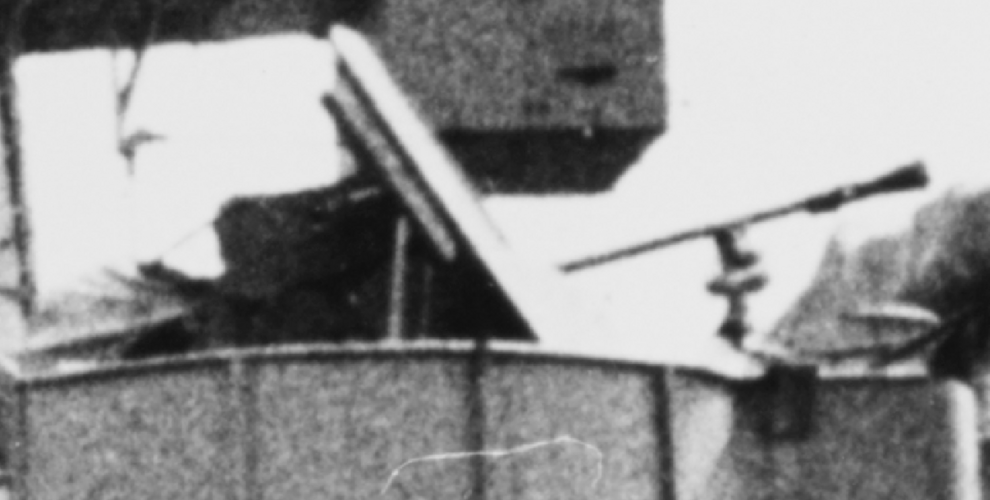
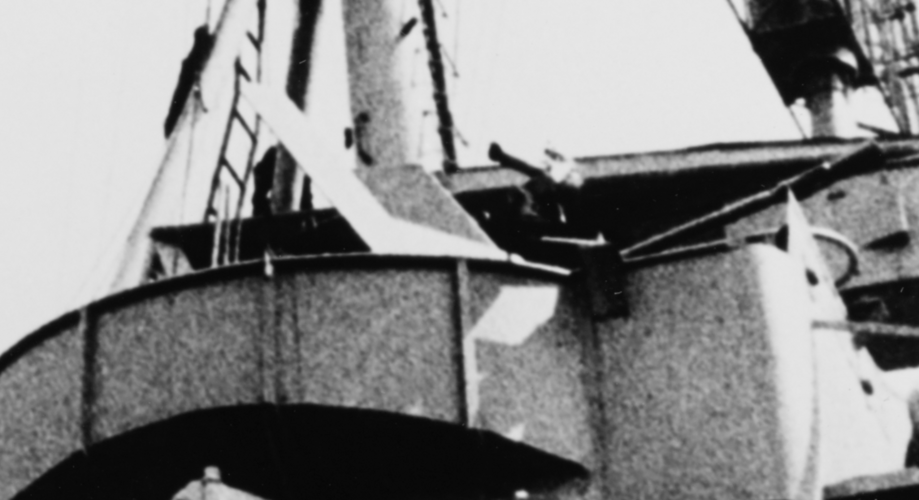
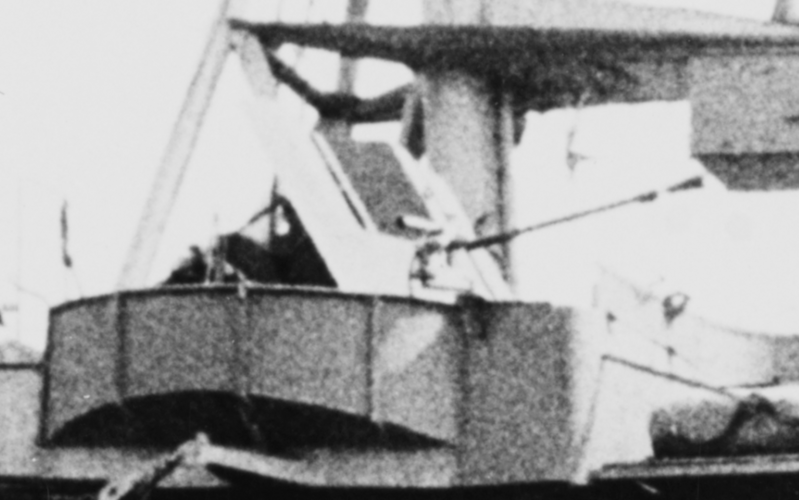
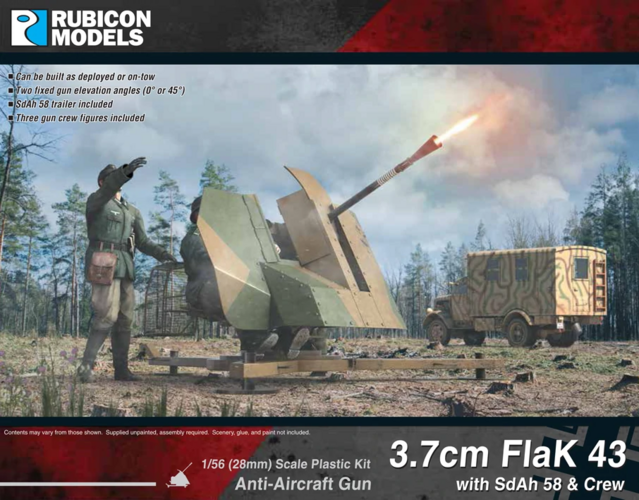
Here you can see USS T-35 (DD-935), postwar and in US hands. On flying bridge wings you can see what somewhat obviously are 3.7cm/57 M43 in Einelafette port and starboard. Here is an additional picture of the M43 single in LM43.
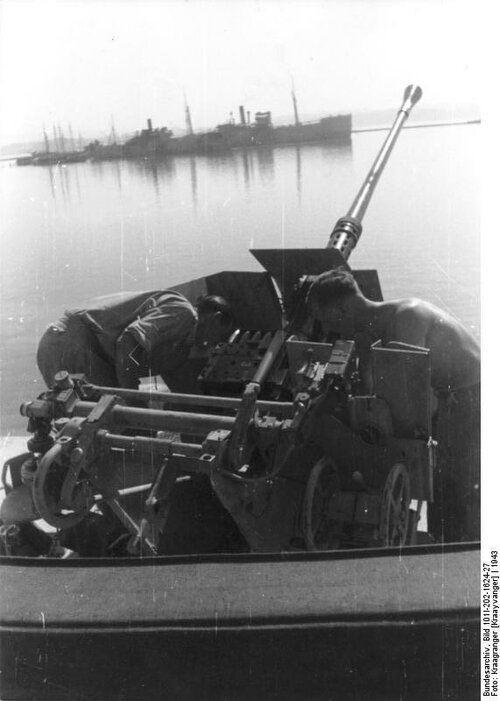
The LM43 appears to be, or be strongly based off of, the single Heer/Luftwaffe mount while the LM44 twin is a modified Doppellafette LM42 from the 3.7cm M42.
3 cm MK 303: 30 x 211 ammunition
This high-velocity gun was developed during WW2 at Brünner Waffenwerke in Czechoslovakia under German control, with the involvement of Krieghoff. It was a gas-operated design using a horizontal wedge lock and seems to have been a scaled-up version of the 2 cm MG 301 (see above). It used "frame feeding" (10-round skeletal magazines). It weighed 185 kg, was 295 cm long with an L/73 barrel and fired at 400 rpm. It was intended for naval Flak applications (initially in Type XXI submarines) but was not ready in time. After the war, development was continued by Czechoslovakia and it entered service with the Czech and other armies in a twin AA mounting, designated M53.
Musgrave states on page 198 (1992 edition) that the "3cm Flak 44" was by Rheinmetall, but on page 566 includes a "3cm Flak M.44" in a list of Mauser projects.
There are three relevant Unterlüß documents, listing the guns, the ammunition and the mountings.
The gun document includes the following 3 cm projects (among others):
MK 411 (engine-driven, 900 m/s)
Mk 303 (Brünner Waffenwerke); 400 rpm; 185 kg; 1,060 m/s; gas operated; naval Flak for U-Boote and S-Boote.
3 cm Flak M 44 (300M); Mauser project; gas operated; 400 rpm; 100 kg; 920 m/s.
3 cm Flak 4M 44 (I think - I only have a poor quality photocopy); Rheinmetall-Borsig (competitor for the above); 420 rpm; 140 kg; 920 m/s.
The ammunition document includes:
3 cm MK 411 HE-T; 440 g; 900 m/s
3 cm MK 303 (Br); M-Geschoss 330 g (72 g HE); 1100 m/s
The mounting document includes:
3 cm Flak M 44 twin mounting for S-Boote; 690 kg.
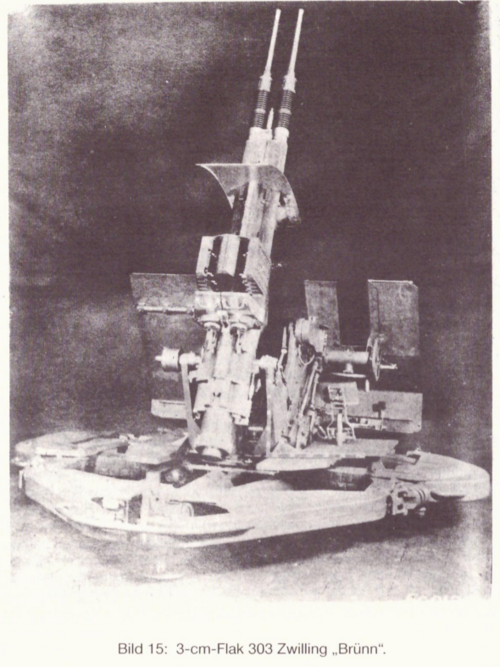
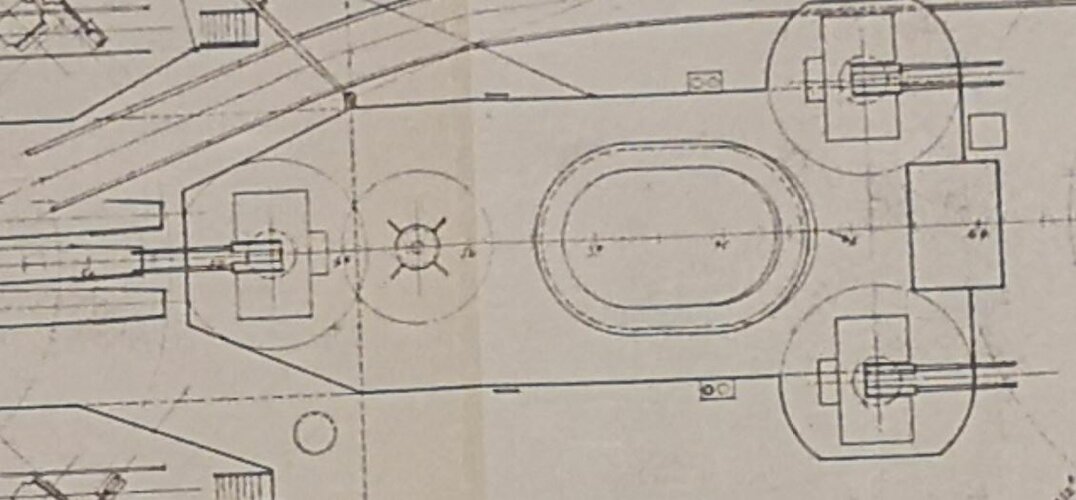
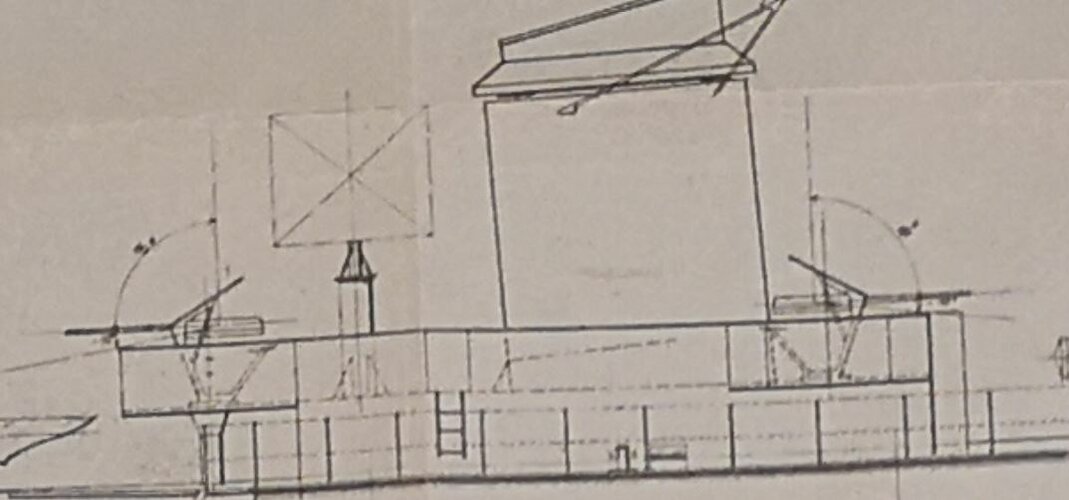
Bottom two images show the 3cm twin mounts intended for Flottentorpedoboot 1944. Sources are weird for these guns, so I wouldn't say that they're the 3cm MK 3O3 Brunn guns. Die Deutschen Flottentorpedoboote 1942-1945 states these are "3-cm-Flak M 44 L/44 in funf Doppellafetten M 44"...meaning these would be...3cm MK 103's? Die Deutsche Kriegsmarine 1935-1945 Band 7 - Die Entwicklungsgeschichte der Zerstorer und Torpedoboot says they are "3-cm-Flak L/44,6 M-44 in Doppellafetten LM-44" which is without a doubt aiming for the 3cm MK 103. Still, it makes me wonder if there was a mixup between the MK 103 and the Mauser 3cm M44 design.
3 cm Flugabwehrkanone M44 (300 (gerät?)M)
Overall Lenght: 3145mm
Barrel lenght (L/73): 2200mm
Weight: 170 or 185kg
Estimated Muzzle velocity: (M-G)900-920; (HE) 800; (PzG) 725m/sec.
Weight projectile: (M-G) 0,33 kg; (HE) 0,44 kg; (PzG) 0,5 kg.
Estimated rate of fire: 400 rounds p/minute
Mauser, Oberndorf
Taken from Gander/Chamberlain`s "Enziklopädie Deutscher Waffen", Motorbuch Verlag.
Rheinmetall-Borsig 3cm for comparison:Mauser 3 cm Flak M44 data:
400 rpm, rotating bolt (schwenkverschluss?);
2,5 m gun lenght (1,6 m barrel);
forward cartridge ejection;
friction muzzle brake;
900-920 m/sec muzzle speed (with mine shell), 800 with HE, 725 with PzG;
Shell weights: Mine shell, 0,33 kg/ HE shell, 0,44 kg/ PzG 0,5 kg;
165 kg weight.
As you can see, the Ftb 1944's mounts elevate -10/+90 so Rheinmetall is out of consideration.Rheinmetall 3 cm M44 data:
400-420 rpm;
lenght as Mauser`s;
180 kg gun weight, 240 kg mount, combat weight 600 kg;
360º rotation, -10/+75º elevation;
Ammo same as Mauser`s.
A Mauser document states that Rheinmetall relocated develoment of 3 cm swivel mounts for E-boats to the Brünner Waffenfabrik, as well as the U-boat (Type XXI) double mount to the Czech company Bata, at Zlin. Preliminary work was probably undertaken by Rh (my guess). Rheinmetall was also designing a triaxial single mount for the M44, as well as a quadruple mount.
Some extra on MK 411, for the curious:
"2,8 cm Gerät 411: 28 x 216B ammunition.
A Krupp project initiated in 1941 for a motor cannon driven by the aircraft engine, and therefore presumably limited to use with vee-engines, with the gun fitting between the cylinder banks and firing through a hollow propeller hub. This used a large and powerful cartridge, but was unsuccessful. It is sometimes confused with the 3 cm MK 411, about which virtually nothing seems to be known except the calibre."
Further digging in Petter's book (somewhat slow due to the need to type the German text into a translator) reveals that the "Motorkanone MK 411" was designed in two calibres, 28 mm and 30 mm. The 28 x 216B round exists (a couple of examples in a collection) but the 30 mm is unknown.
Petter's designation for this project (both 28 mm and 30 mm) is MK 411, but when he specifically describes the 28 mm version he designates it Gerät 411.
Anyway, the MK 411 was clearly designed for aircraft use, as instead of being gas or recoil operated, the mechanism was driven by the aircraft engine as the Motorkanone designation indicates. The gun would have fired through the hollow propeller hub. Weight of a practice projectile was 300 g; MV not known. Both steel and brass-cased versions of the ammunition survive, both dated 1941.
he has photos and drawings of the 34 x 149. I actually have one of the cases for that, and have had a replica M-Geschoss projectile made. I have no idea what gun it was made for.
The brass-cased MK 411 is shown below. I hope Mr Petter doesn't mind me showing this. I must say that his book is superb - 900 pages on high-quality gloss paper and profusely illustrated. It is expensive, but a must-have for any serious student of this subject. The title is Munition für deutsche Flieger Bordwaffen bis 1945. He can be contacted at: Petter.Franz at t-online.de
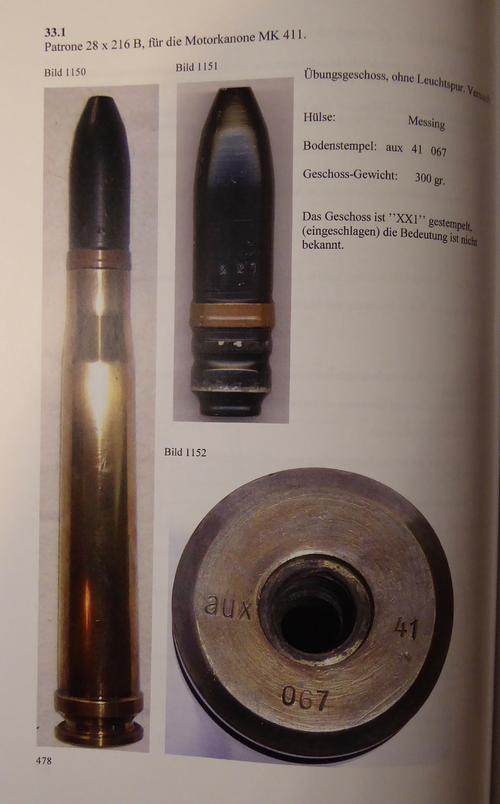
Still hoping that one day I will get that dump of information on the 3cm/44 MK 103 so I can add it in further detail to this list.
- Joined
- 1 February 2011
- Messages
- 2,933
- Reaction score
- 3,611
And interesting weapon choice of 33cm which could go anywhere from 285mm to 334mm... or inspired by the WW1 335mm SK L/45 Gerät 10 gun of 1910.
35cm might inspired by the SK L/45 C/14 gun
Presumably all of these new guns are /50+ calibre
35cm might inspired by the SK L/45 C/14 gun
Presumably all of these new guns are /50+ calibre
I believe its due to French influence, Raeder considering 33cm and 35cm as maximum caliber period, to counter against French new capital ships (as the same early battleship "F" also armed with 8x33cm and 35cm (or 35.5cm) gun on 35000 tons hull), now i did recall someone post a page from unknown book source proposed a Scharnhost design armed with 28.3cm in quadruple all forward (it was on Wows old forums before they nuke it).
_Sarcasticat_
Die Katze.
- Joined
- 16 April 2020
- Messages
- 364
- Reaction score
- 351
This was a good link. Reminded me to do some searching.Anyway, if you want to know more about panzerschiff D preliminaries and study, i suggest you read this thread (is in German), some guys upload picture of panzerschiff D plans (sadly they're all from 2007 so link are dead).
The 30.5cm armed proposed Panzerschiff D did exists but very few, mainly because Raeder obsessions, he suggests that if 33cm isn't ready yet, then 30.5cm should take place (mentioned in those 26000,26500 tons studies), and then the mysterious 7th and 8th replacement (supposedly German only plans to replace six aged pre-dreadnoughts) but two more replacement come along (this demand a study of 25000 tons, armed with 30.5cm, interesting).
Found some things such as:
A few additions from Hanfried Schliephake, "Aircraft Armament" and "Handbook of Aircraft Weapons Ammunition 1936-1945":3 cm MK 103:Caliber 30 mmWeight of the weapon 145 kgInstallation weight as a motor cannon 165 kg
Length of the barrel 1338 mm
Weight of the empty 100 shots - belt 12 kg belt
weight with 100 H.Pzgr.L'spur approx. 94 kg
belt weight with 100 M.Gr. approx. 92 kg
cadence 380 (H.Pzgr.L´spur) or 420 (M.Gr.) rounds/min.
Vo 940 (H.Pzgr.L´spur) or 860 (M.Gr.) shots/min.
Penetration performance of the H.Pzgr.L'spur 110 mm at 300 m
projectile weight:
330 g M-Gesch.Patr.L´spur 103 o.Zerl., M-Gesch.cart. 103 m.Zerl.Ausf.C, M-Gesch.Patr. 103 o.Zerl.Ausf.A and M-Gesch.Patr. 103 m.Zerl.Ausf.A
440 g Sprgr.Patr.L´spur 103 o.Zerl.
ammunition Bullet weight in g Explosive charge in g propellant charge in g penetration performance cartridge weight in g Vo to m/s 3cm explosive shell cartridge L'spur without fragmentation 440 27g 107+4 - 890 800 3cm explosive shell cartridge L'spur 103 without fragmentation 440 ? ? ? ? 750 3cm M projectile cartridge L'spur without fragmentation 295 61g 112+4 - 770 910 3cm M projectile cartridge L'spur 103 without fragmentation 330 ? ? ? ? 860 3cm M projectile cartridge L'spur 103 with splitter Ausf. C 330 72g Nitropentaker ? ? ? 860 3cm M projectile cartridge L'spur 103 without splitter Ausf. A 330 85g HTA 41 ? ? ? 860 3cm M projectile cartridge L'spur 103 with splitter Ausf. A 330 85g HTA 41 or PETN ? ? ? 860 3cm anti-tank grenade cartridge L'spur without fragmentation 530 14g 97+4 25 mm armor at 300 m at 60° angle of impact 530 700 3cm M projectile cartridge L'spur without fragmentation 330 72g Nitropentaker 110+4 - 778 900 3cm tank incendiary shell cartridge (Elektron) without fragmentation 500 electron shell + 9g 98+4 20 mm shipbuilding steel up to 1000 m at 60° impact angle or up to 300 m at 45° 935 725 3cm H-Panzergranatpatrone L'spur without fragmentation 350 Special steel core in light metal shell 116+4 70 mm armor at 300 m at 60° impact angle, 100 mm at 90° 804 960 3cm anti-tank incendiary shell cartridge L'spur without fragmentation 455 5.2g + 6g 110+4 26 mm armor at 300 m at 60° impact angle, 32 mm at 90° 903 800
[For 3cm MK 101/103]
"330g" +/- 8g
Ausf. C projectiles are more streamlined for increased ballistic performance at the cost of capacity and thus have a maximum of 72g instead of 85.
More on 30mm projectiles:
The journey thus continues.Regarding the development of the 12.8 cm Flak 40, some things are still not entirely clear to me. In his standard work , Die deutsche Geschütze 1939 - 1945
, which I have already quoted several times, von Senger and Etterlin write : " Use: in a battery formation of 4 guns with Luftwaffe and naval anti-aircraft guns, primarily for object protection against high-level attacks. In 1936 the first order was placed with Rheinmetall and in 1938 the first test guns were sent to Wa. delivered. In December [1938] 100 guns were ordered. At the end of 1941 the troops received the first batteries. [...] assessment
: This gun was probably the most effective anti-aircraft gun in the 1939/45 war. However, it was too heavy for mobile use. It performed well until the end of the war, but from the end of 1944 it was at the limit of its capabilities against high-level attacks. The development of the Type 45 was not completed by the end of the war.« [p. 202]
In the Waffen-Arsenal special volume S-44 "The flak towers in Berlin, Hamburg and Vienna 1940 - 1950" by Michael Foedrowitz [Podzun-Pallas 1996] it says with regard to the 12.8 cm twin Flak 40:
»On September 23, 1940, the anti-aircraft artillery inspection (dept. fortifications) reported the results of a meeting of the departments involved with the project. The choice of heavy anti-aircraft guns caused some concern, because the Navy could only provide double-barreled 10.5 cm anti-aircraft guns in 1½ years. The ship anti-aircraft guns were three-axis guns, equipped with an angular axis (cantilever mechanism) to compensate for ship movements and were therefore considerably more complicated than conventional stationary anti-aircraft guns on land. The Navy had developed a 12.8 cm anti-aircraft gun
for stationary use, but this would also only be available in 1½ years. It was suggested that the bases on the anti-aircraft towers should be designed for the 12.8 cm anti-aircraft guns and first provisionally fitted with the 10.5 cm caliber. [...]
A gun weight of about 30 tons and a recoil force of 25 tons were calculated.« [p. 5]
Accordingly, the development of the 12.8 cm Flak 40 went back to the Navy. Siegfried Breyer ( »Battleships and Battlecruisers 1905 - 1970« says with regard to the conversion of the »Gneisenau« started in
1942 : » Of the planned rearmament, only the 6 - 38 cm SK were safe. All the other armament - in particular the replacement of the 15 cm SK and the 10.5 cm Flak with 12.8 cm dual-purpose guns
however, has not yet been definitively determined. Since it could only be made on the basis of written records from the K-Office, the sketch is deemed to have been made and is to be included with the usual reservations.« [p. 319]
The sketch referred to above is in the book on p. 318 and shows GU with 11 x 12.8 cm twin turrets, i.e. a broad side of 6 x (2) 12.8 cm (12 turrets).
There are two of these on each side of the ship on the upper deck instead of the previous 15 cm twin turrets, the two 15 cm single carriages per side are omitted and three 12.8 cm twin turrets are located one deck higher at the positions of the previous 10.5 cm twin anti-aircraft guns. Another banked amidships behind tower C instead of the 10.5 cm twin anti-aircraft guns previously installed there.
According to this, a 12.8 twin flak tower must have been under development in 1942. Anything known about this?
In the meantime, has a relevant sketch been found in the files of the Warship Construction Office returned by the Soviet Union to the GDR in 1988, which documents the planned conversion of the Gneisenau in 1942/43? So far, apart from the extension of the forecastle and the conversion to 3 x (2) 38 cm SK C 34, not so much concrete information (especially plans) has been published.
Last edited:
Data table for 28cm, 35cm and 38cm (number of guns, broadside weight, round per minute, armor penetration, range etc, you get the idea).
- Joined
- 1 February 2011
- Messages
- 2,933
- Reaction score
- 3,611
I presume 35cm/54 cannon?Data table for 28cm, 35cm and 38cm (number of guns, broadside weight, round per minute, armor penetration, range etc, you get the idea).
_Sarcasticat_
Die Katze.
- Joined
- 16 April 2020
- Messages
- 364
- Reaction score
- 351
I plan to release a little bit about the 15cm/48 TK C/36T and the 12.8cm/45 SK C/41 turret comparison, with some stuff about the 12.8cm/45 SK C/41 and the 12.8cm/45 SK C/34.
- Joined
- 22 April 2012
- Messages
- 2,257
- Reaction score
- 2,296
@_Sarcasticat_ , thank you for your work here, a wonderful effort.
I am not vey familiar with German 1930s-1940s ship designs so much of what you have found is new to me but there are a couple of things that stick out:
The three and four gun 40.6cm turrets from 1937/38 open up some fascinating what-ifs in terms of capital ship design, especially noting that three-turret H-class design with the super-firing twin 105mm aft. I do hope someone turns up a ship design with these mountings.
The Z45 destroyer is very interesting. Its a great compare and contrast with the contemporary, and similarly sized, British Daring class. One thing that surprised me is the relatively low elevation of the 12.8cm guns, it looks like just 55 degrees compared to 80+ degrees in most British and US DP mountings, which suggests it would have been compromised in the AA role compared to its allied contemporaries.
I am not vey familiar with German 1930s-1940s ship designs so much of what you have found is new to me but there are a couple of things that stick out:
The three and four gun 40.6cm turrets from 1937/38 open up some fascinating what-ifs in terms of capital ship design, especially noting that three-turret H-class design with the super-firing twin 105mm aft. I do hope someone turns up a ship design with these mountings.
The Z45 destroyer is very interesting. Its a great compare and contrast with the contemporary, and similarly sized, British Daring class. One thing that surprised me is the relatively low elevation of the 12.8cm guns, it looks like just 55 degrees compared to 80+ degrees in most British and US DP mountings, which suggests it would have been compromised in the AA role compared to its allied contemporaries.
Last edited:
_Sarcasticat_
Die Katze.
- Joined
- 16 April 2020
- Messages
- 364
- Reaction score
- 351
Thank you. I love doing this, and the benefits are severalfold.@_Sarcasticat_ , thank you for your work here, a wonderful effort.
I am not vey familiar with German 1930s-1940s ship designs so much of what you have found is new to me but there are a couple of things that stick out:
The three and four gun 40.6cm turrets from 1937/38 open up some fascinating what-ifs in terms of capital ship design, especially noting that three-turret H-class design with the super-firing twin 105mm aft. I do hope someone turns up a ship design with these mountings.
The Z45 destroyer is very interesting. Its a great compare and contrast with the contemporary, and similarly sized, British Daring class. One thing that surprised me is the relatively low elevation of the 12.8cm guns, it looks like just 55 degrees compared to 80+ degrees in most British and US DP mountings, which suggests it would have been compromised in the AA role compared to its allied contemporaries.
I totally agree. I'd love to see what happens when someone makes a design using the 53cm/45 twin. Models for some have been made by Tzoli in Shipbucket style so I am interested to see what becomes of that.
Z45, also known as the Type 1945, is a rather interesting design among the other German destroyers. While destroyers starting with the Type 1942 (Z51) design had adopted diesel, this final destroyer design has reverted to steam. Besides the fact that the Wehrmacht had all but capitulated and new designs were at that time all but pointless, it does present something of an interesting "last-moment" glimpse of what they had in mind for their future of design. Heavy "DP" and AA firepower (12.8cm's and 5.5/3cm) with a moderate torpedo armament (for 1944/45 destroyers and designs) and high speed, which was most attainable via steam at that time. As with the torpedo boats, such as the Flottentorpedoboot 1944, speed and AA firepower had been deemed paramount. Even the legendary V12Z 32/44 diesel engines under testing until 1945 could not, on paper, provide the same theoretical power as steam in their eyes...and it was still heavy and took up quite some space. The "reversion" to steam allowed for a smaller and lighter ship with a heavier main armament. Plus it was "tried and true" (more like something they at least knew), while testing with the V12Z 32/44 had shown teething issues not unlike the M9Z 42/58 aboard the Deutschland-class. Vibration, noise, the works. Not like the KM intended to operate outside of the Baltic or North Sea by and large...unlikely their DDs wouldn't capsize in a heavy storm elsewhere...so diesel's range was a mute point.
To elaborate, it would take eight V12Z 32/44 to make 80,000 hp (though this could be easily exceeded if you chose to include an intercooler and turbo charger, but things like the turbocharger were deemed an unnecessary complexity and would not have been added beyond the Z51) which compared with a steam plant of the same power is very heavy. Regardless, designs like the Type 1942C/44 sought to do just that. Might have been better to do that, as diesels provide a good ballast to offset potential increases in deck weight, like including a fourth 12.8cm twin, perhaps?
On the lack of elevation for the LM/41 twin (it's 52 degrees) I believe that was an effect of cutting down weight on the turret. Not that Germany could not produce turrets with HA elevation - see the Drh L C/38 twin for the 15cm/48 TK C/36 which could elevate to 65 degrees. However that turret weighed 60+ tonnes and the LM/41 just 40.
The LM/41 is the final evolution of a series of three turrets intended for German destroyers. Starting with the Drh L C/38 leading to the briefly-lived Drh L C/38 with 12.7cm/45 SK C/34 guns (for designs like the Type 1938B and Type 1941 destroyers) and finally down to the LM/41. Each version was lighter than the last, which tells me they were looking to cut weight more than anything.
I'll have to reverify but I'll get back to you when I can, but it doesn't appear to be a limitation of the turret or its design.
- Joined
- 28 November 2006
- Messages
- 711
- Reaction score
- 734
Do you have any information on expected rate of fire of the 12.7-12.8 cm mountings shown in the drawings?They're all in RM 24-2, including some varies other than 12.7cm mounts, but i'll upload all here, i also found interiors of C/34.f turret (apparently there are two variants, f1 and f2, f2 have shorter barrel length only at 17600m).
Piotr
_Sarcasticat_
Die Katze.
- Joined
- 16 April 2020
- Messages
- 364
- Reaction score
- 351
Ah, sorry.I'm not using Shipbucket style aka pixel style but rather my own
Generally it's "15-18 RPM", but that's the absolute optimum ROF in most cases for shipboard mountings. Actual ROF is something closer to 12-14 RPM. For the 12.7cm/45 SK C/34 in poor weather conditions the ROF is "similar to the 15cm C/36" which is about 7-10 RPM.Do you have any information on expected rate of fire of the 12.7-12.8 cm mountings shown in the drawings?They're all in RM 24-2, including some varies other than 12.7cm mounts, but i'll upload all here, i also found interiors of C/34.f turret (apparently there are two variants, f1 and f2, f2 have shorter barrel length only at 17600m).
Piotr
For these weapons you would most safely say 12-14 RPM.
_Sarcasticat_
Die Katze.
- Joined
- 16 April 2020
- Messages
- 364
- Reaction score
- 351
Okay so short answer for the poor elevation is that there was a reduction in width between the guns which directly caused a decrease in elevation. I do not know the specifics of why this is the case, but I know why they did this. In the end, it was the result of a desire to reduce weight, which came from modifying the 15cm/48 TK C/36 Drh L C/38 twin turret design and reducing its armor thickness to just 8mm. When decreasing the size of the turret, the guns are placed closer together, and the elevation is decreased as a result.
I will elaborate further, with pictures and all, but this may take 3 weeks due to my situation.
I will elaborate further, with pictures and all, but this may take 3 weeks due to my situation.
Last edited:
_Sarcasticat_
Die Katze.
- Joined
- 16 April 2020
- Messages
- 364
- Reaction score
- 351
Wanted to do as I said 3 weeks ago and deliver on Zerstorer armaments.
I'll put this out of the way right now, I got most of my data from this page: https://wiki.wargaming.net/ru/Navy:127-мм_орудие_SK_C/41
Surprisingly enough there is a lot of data on this page.
The short of it is that the SK C/41 is, essentially, a Flak 40 derivative with a 45-caliber barrel. The barrel itself is different from either the SK C/34 or the Flak 40, but the breech isn't particularly different from the latter. Some accommodations were made to fit the new gun into the new Drh L C/41 turret, but they are minor. I'll leave the specifics to be read from the link.
Ammunition is from the SK C/34 but pressed into a new brass cartridge to form unitary ammunition. This solves the issue of shell supply as the Kriegsmarine obviously has a monopoly on SK C/34 shells. Interestingly, the L/4,5 Kz (mHb) remote-fuse anti-aircraft round is quite powerful and would no doubt be much more effective than its point-detonation nose fuse counterpart in the surface role.
In regards to the turret, the history is a little simple:
15cm/55 SK C/28 --> 15cm/48 Drh L C/38 ---> 12.8cm/45 Drh L C/38 --> 12.8cm/45 SK C/41 in Drh L C/41 | 12.8cm/61 KM40 in LM40.
It's a series of attempts to compress and lighten the preceding design, and was largely successful by reducing armor thickness, cutting down on internal space, and the utilization of weight-saving techniques like welding.
There is a mystery related to the 12.8cm/45 SK C/34 in the Drh L C/38 twin. Little is actually known about it, and one has to wonder if it's just the 15cm twin but replaced with 12.8cm guns, with that being it. For the Type XI submarine, which also uses 12.8cm/45 SK C/34 guns in a "Drh L C/38" twin turret, albeit a quite rounded version (probably to better withstand pressure underwater), weighs in at 42.2 tonnes. Armor data for it is unknown. The Drh L C/41 has 8-10mm of armor and weighs 40.5 tonnes, so I would think it safe to say that the Type XI's twin turrets have similar armor.
You can find examples of the 12.8cm/45 in the Drh L C/38 on the designs Type 1938B and Type 1941, as well as the Kolonialkanonenboot. They are not Drh L C/41 examples - for the 1938B, the SK C/41 wasn't even a twinkle in the Reich's eye at that point. In addition to this they have an elevation of 60 degrees, 8 more than the C/41 and 5 less than the 15cm version. This is likely due to the very same reason the C/41 has a 52-degree elevation - reducing the space between the guns. You can see the 60-degree elevation also on the Type 1941 as well. The use of the SK C/34 and the Drh L C/38 was one of the major reasons why the Type 1936C, with its modern Flakleitgerat M42 and newer turrets/guns (with 52-degree elevation, I might add) was chosen instead. The drawings of the turrets on the 1938B and 1941 don't even look the same as those with the Drh L C/41.
Also, for some reason, sources vary on the weight of the 15cm/48 Drh L C/38. Is it 60.4 tonnes? Is it 62.5? I dunno.
Here are some pictures from WoWs. WoWs is very...very...far from perfect, but I think they did a good job with the turret models. Or at least well enough.




The similarities are obvious right off the bat. The Drh L C/41 is as squished and downsized as possible by comparison to the larger, 15cm Drh L C/38.
-
Wanted to do this for a while, and I hope I cleared up a bit of mystery and misconception regarding KM DD armaments. Now, what I'd really like to know is more about the 12.8cm/61 and it's LM40 turret...
Any questions please ask, if I can't answer them then maybe we can have a discussion on it. I encourage you to click the link if you want more specifics on the SK C/41.
I'll put this out of the way right now, I got most of my data from this page: https://wiki.wargaming.net/ru/Navy:127-мм_орудие_SK_C/41
Surprisingly enough there is a lot of data on this page.
The short of it is that the SK C/41 is, essentially, a Flak 40 derivative with a 45-caliber barrel. The barrel itself is different from either the SK C/34 or the Flak 40, but the breech isn't particularly different from the latter. Some accommodations were made to fit the new gun into the new Drh L C/41 turret, but they are minor. I'll leave the specifics to be read from the link.
Ammunition is from the SK C/34 but pressed into a new brass cartridge to form unitary ammunition. This solves the issue of shell supply as the Kriegsmarine obviously has a monopoly on SK C/34 shells. Interestingly, the L/4,5 Kz (mHb) remote-fuse anti-aircraft round is quite powerful and would no doubt be much more effective than its point-detonation nose fuse counterpart in the surface role.
In regards to the turret, the history is a little simple:
15cm/55 SK C/28 --> 15cm/48 Drh L C/38 ---> 12.8cm/45 Drh L C/38 --> 12.8cm/45 SK C/41 in Drh L C/41 | 12.8cm/61 KM40 in LM40.
It's a series of attempts to compress and lighten the preceding design, and was largely successful by reducing armor thickness, cutting down on internal space, and the utilization of weight-saving techniques like welding.
There is a mystery related to the 12.8cm/45 SK C/34 in the Drh L C/38 twin. Little is actually known about it, and one has to wonder if it's just the 15cm twin but replaced with 12.8cm guns, with that being it. For the Type XI submarine, which also uses 12.8cm/45 SK C/34 guns in a "Drh L C/38" twin turret, albeit a quite rounded version (probably to better withstand pressure underwater), weighs in at 42.2 tonnes. Armor data for it is unknown. The Drh L C/41 has 8-10mm of armor and weighs 40.5 tonnes, so I would think it safe to say that the Type XI's twin turrets have similar armor.
You can find examples of the 12.8cm/45 in the Drh L C/38 on the designs Type 1938B and Type 1941, as well as the Kolonialkanonenboot. They are not Drh L C/41 examples - for the 1938B, the SK C/41 wasn't even a twinkle in the Reich's eye at that point. In addition to this they have an elevation of 60 degrees, 8 more than the C/41 and 5 less than the 15cm version. This is likely due to the very same reason the C/41 has a 52-degree elevation - reducing the space between the guns. You can see the 60-degree elevation also on the Type 1941 as well. The use of the SK C/34 and the Drh L C/38 was one of the major reasons why the Type 1936C, with its modern Flakleitgerat M42 and newer turrets/guns (with 52-degree elevation, I might add) was chosen instead. The drawings of the turrets on the 1938B and 1941 don't even look the same as those with the Drh L C/41.
Also, for some reason, sources vary on the weight of the 15cm/48 Drh L C/38. Is it 60.4 tonnes? Is it 62.5? I dunno.
Here are some pictures from WoWs. WoWs is very...very...far from perfect, but I think they did a good job with the turret models. Or at least well enough.
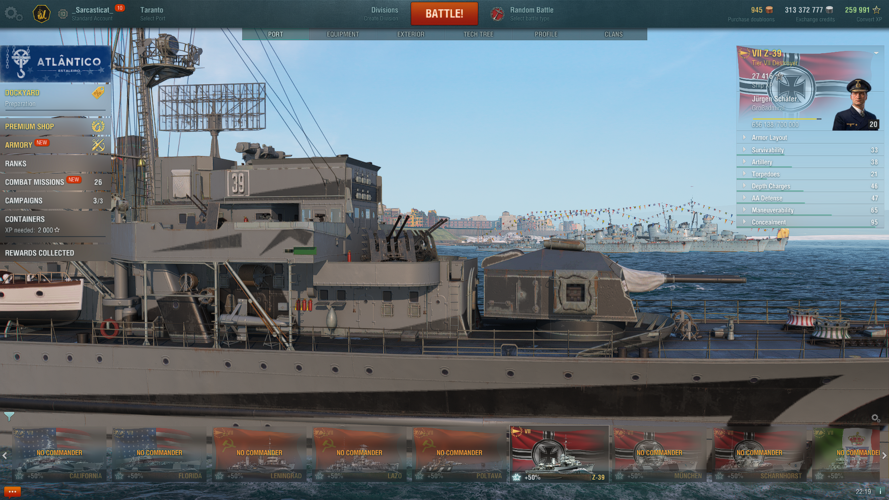
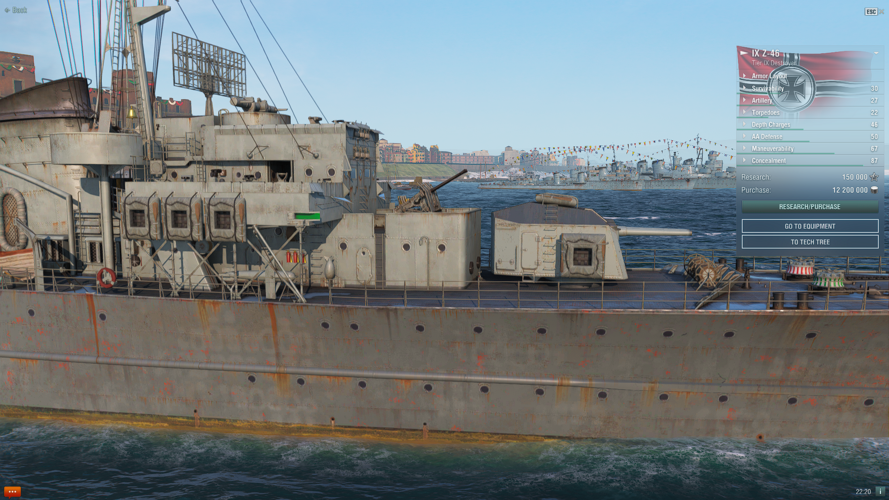
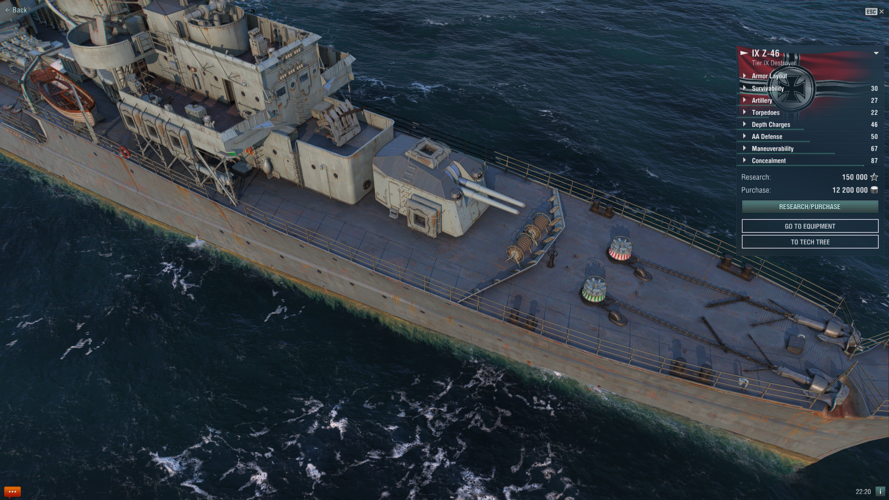
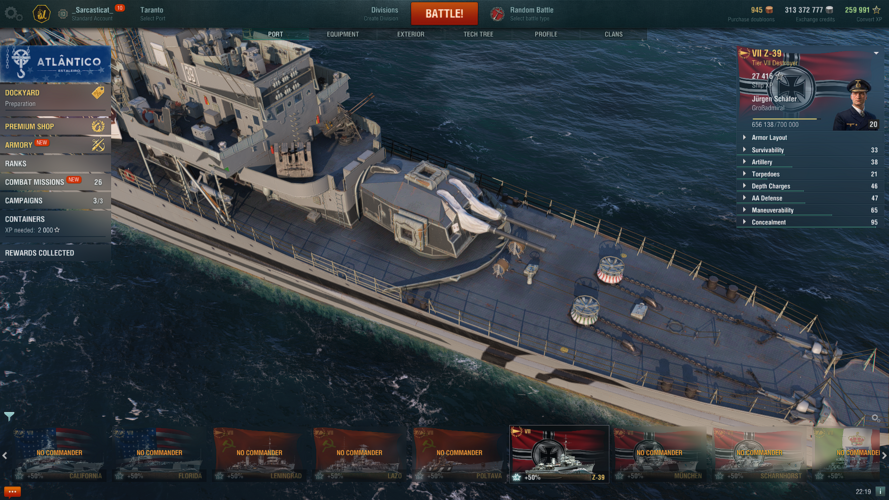
The similarities are obvious right off the bat. The Drh L C/41 is as squished and downsized as possible by comparison to the larger, 15cm Drh L C/38.
-
Wanted to do this for a while, and I hope I cleared up a bit of mystery and misconception regarding KM DD armaments. Now, what I'd really like to know is more about the 12.8cm/61 and it's LM40 turret...
Any questions please ask, if I can't answer them then maybe we can have a discussion on it. I encourage you to click the link if you want more specifics on the SK C/41.
Attachments
Last edited:
_Sarcasticat_
Die Katze.
- Joined
- 16 April 2020
- Messages
- 364
- Reaction score
- 351
_Sarcasticat_
Die Katze.
- Joined
- 16 April 2020
- Messages
- 364
- Reaction score
- 351
That's it, although it is rather sketchy.View attachment 680579Once again, thank you very much for sharing. Is there any chance to see a Schlachtschiff H twin 3,7 cm Flak armoured turret more closely?
This small thing? I never even realized it was there. Unfortunately I have nothing on it.
_Sarcasticat_
Die Katze.
- Joined
- 16 April 2020
- Messages
- 364
- Reaction score
- 351
Presenting my evidence that the 105mm Flak 38 is actually the mysterious 10.5cm/52 SK C/36.
This is what started it:


From there, I decided to take a look at what we have between the guns.
Construction year: 1936
Barrel length: 52 caliber
Bore: 105mm.
Produced: 4,200, kept mostly within the Reich's borders.
Remember that "C/XX" is construction year, meaning the gun has been produced. With so many "useless" and "bulky" land-based 105mm just sitting around, it's not hard to picture that these 4200 guns could find another home.
Honestly, it's the only candidate that even comes close to matching.

Biggest mystery now is the mount. I'd like to know the characteristics of it someday.
In another interesting plot twist, I found that the 3cm guns on Ftb 1944 aren't actually MK 303 models, but MK 103's. I had at first thought they were rather long-looking and came to the conclusion that they were most likely the longer MK 303, but after carefully measuring I've come to see that the measurements are almost 1:1 to the 3cm/45 MK 103.
Apologies, this was incorrect. They are 3cm/73 MK 303 (Br) guns.

This is corroborated in a source: (Said source is INCORRECT, disproven via primary document.)

Still wondering how brutal this little thing could have been if they'd been replaced with 3cm/45 Flakvierlings. Just a 334 kg increase using 30mm on the same Flakvierling chassis - ammo notwithstanding.
edit:^this would have still been cool as hell.
This is what started it:
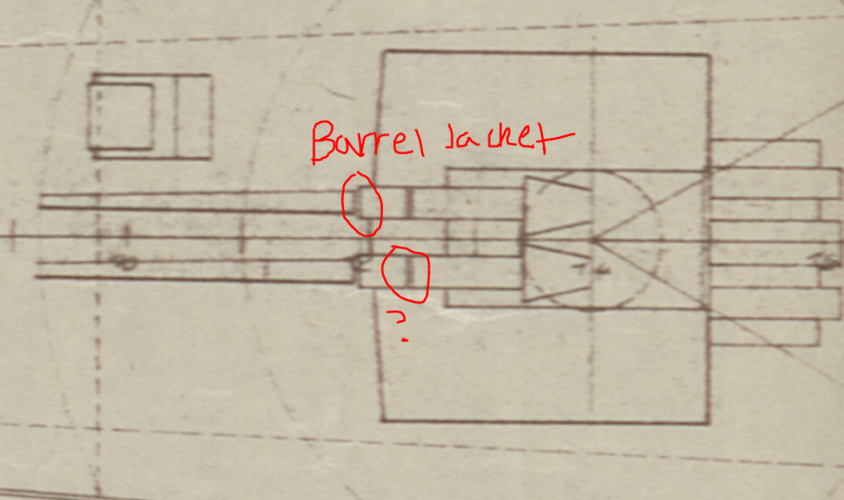
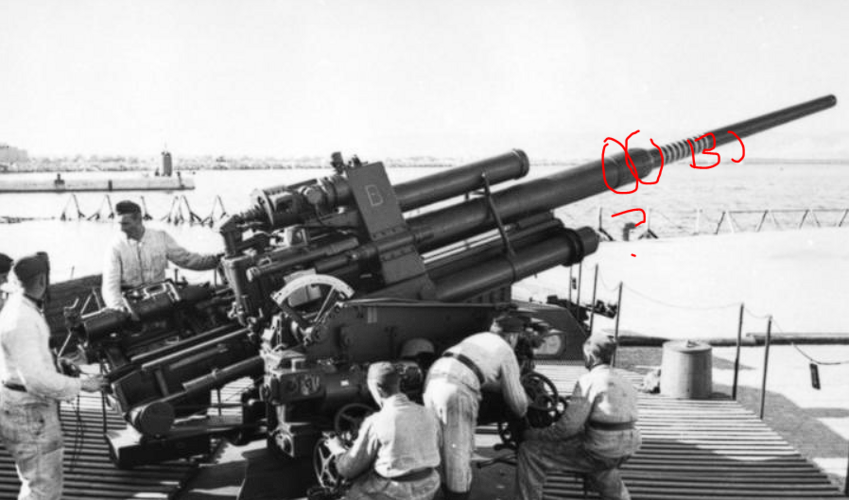
From there, I decided to take a look at what we have between the guns.
Construction year: 1936
Barrel length: 52 caliber
Bore: 105mm.
Produced: 4,200, kept mostly within the Reich's borders.
Remember that "C/XX" is construction year, meaning the gun has been produced. With so many "useless" and "bulky" land-based 105mm just sitting around, it's not hard to picture that these 4200 guns could find another home.
Honestly, it's the only candidate that even comes close to matching.
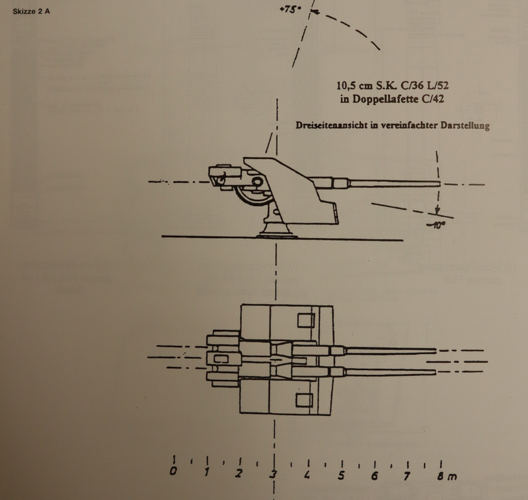
Biggest mystery now is the mount. I'd like to know the characteristics of it someday.
Apologies, this was incorrect. They are 3cm/73 MK 303 (Br) guns.
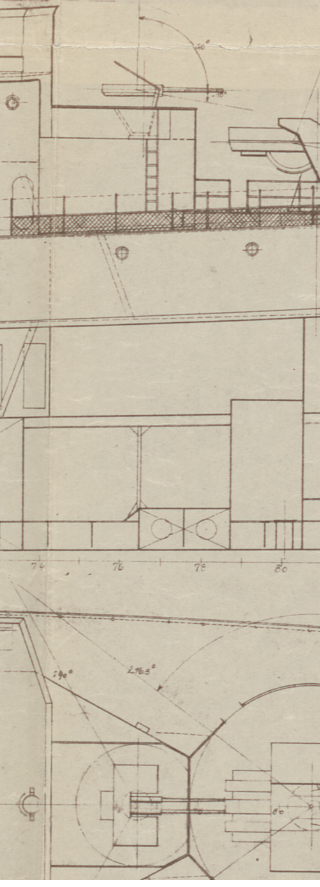
This is corroborated in a source: (Said source is INCORRECT, disproven via primary document.)
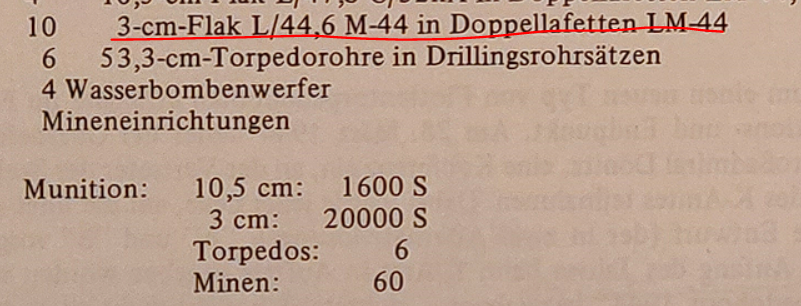
Still wondering how brutal this little thing could have been if they'd been replaced with 3cm/45 Flakvierlings. Just a 334 kg increase using 30mm on the same Flakvierling chassis - ammo notwithstanding.
edit:^this would have still been cool as hell.
Last edited:
_Sarcasticat_
Die Katze.
- Joined
- 16 April 2020
- Messages
- 364
- Reaction score
- 351
Added a drawing for the single 5.5cm/77 Gerat 58, courtesy of a Discord user named _Tancred who notified me this had been digitized.
 drive.google.com
drive.google.com
5.5cm/77 Gerat 58 - Google Drive
 drive.google.com
drive.google.com
_Sarcasticat_
Die Katze.
- Joined
- 16 April 2020
- Messages
- 364
- Reaction score
- 351
So after some re-review, I've come across a slight mistake...
I had said a few days ago that the Flottentorpedoboot 1944 was to carry the 3cm/45 MK 103 in twins...but this does not appear to be quite right. Taking a look at the lengths again, it appears that I misread. It wasn't 2.5m o/a...it was 3m. Well, more closely 3.1m. The 3cm MK 103 is nowhere near this length - but the 3cm MK 303 is, whether it be 3 or 3.1m (3m = Krieghoff / 3.1m = Brno revision).
What I told an associate of mine:
"It's because [the Ftb 1944 plan] is an early 1944 drawing. The 3cm MK 303 was prospective - design work was ongoing for the weapon at this time and there was even still competition from Rheinmetall-Borsig and Mauser with their "M44" designs. It wasn't until sometime (probably in late) 1943 that the MK 303 project from Krieghoff-Waffenfabrik was even transferred to the Czech company Zbrojovka Brno - or "Brno" for short. There it was slightly lengthened...by 200mm. (199mm to be exact). Thus gave birth to the 3145mm 3cm MK 303(Br).
Beforehand it was simply the MK 303, featuring an overall length of 2946mm...very close to 3m. Almost exactly 3m.
The 3cm MK 303(Br) didn't see production until later in 1944, about mid-1944."
Just speculation, but it makes some sense.
On a slightly related note I had the measures done for Type 1945's 3cm AA battery and they match. 3m. So she is also equipped with MK 303's - though that should be no surprise by 1945. MK 103 isn't putting up much competition to it.
I'm really curious about their mount. I read somewhere that there was a 3cm MK 303 or M44 mount for S-Boote being designed or prototyped and weighing nearly 700 kg, though I do not know if this is for a twin (judging by the weight, most likely) or even if they're the same mounts intended for the Ftb 1944/Type 1945. I really wanna see a plan for it.
I had originally thought that it would have made a sort of unique sense for Ftb 1944 to have carried 3cm/45's given that the base weapon had been in service since 1942 and had seen some limited service in the KM aboard S-Boats. Perhaps it could have been an interim 3cm weapon until the 3cm MK 303 could reach production, I thought, but in hindsight...it really doesn't make a lot of sense other than that it would have made a pretty damn good lightweight alternative to the larger, heavier MK 303, and befitting the rather light construction of the Ftb 1944.
The thing didn't even really see service as a true AA weapon until 1945, and by then of course it was a little ahead of the design period of the Ftb 1944, unlike the MK 303.
I had said a few days ago that the Flottentorpedoboot 1944 was to carry the 3cm/45 MK 103 in twins...but this does not appear to be quite right. Taking a look at the lengths again, it appears that I misread. It wasn't 2.5m o/a...it was 3m. Well, more closely 3.1m. The 3cm MK 103 is nowhere near this length - but the 3cm MK 303 is, whether it be 3 or 3.1m (3m = Krieghoff / 3.1m = Brno revision).
What I told an associate of mine:
"It's because [the Ftb 1944 plan] is an early 1944 drawing. The 3cm MK 303 was prospective - design work was ongoing for the weapon at this time and there was even still competition from Rheinmetall-Borsig and Mauser with their "M44" designs. It wasn't until sometime (probably in late) 1943 that the MK 303 project from Krieghoff-Waffenfabrik was even transferred to the Czech company Zbrojovka Brno - or "Brno" for short. There it was slightly lengthened...by 200mm. (199mm to be exact). Thus gave birth to the 3145mm 3cm MK 303(Br).
Beforehand it was simply the MK 303, featuring an overall length of 2946mm...very close to 3m. Almost exactly 3m.
The 3cm MK 303(Br) didn't see production until later in 1944, about mid-1944."
Just speculation, but it makes some sense.
On a slightly related note I had the measures done for Type 1945's 3cm AA battery and they match. 3m. So she is also equipped with MK 303's - though that should be no surprise by 1945. MK 103 isn't putting up much competition to it.
I'm really curious about their mount. I read somewhere that there was a 3cm MK 303 or M44 mount for S-Boote being designed or prototyped and weighing nearly 700 kg, though I do not know if this is for a twin (judging by the weight, most likely) or even if they're the same mounts intended for the Ftb 1944/Type 1945. I really wanna see a plan for it.
I had originally thought that it would have made a sort of unique sense for Ftb 1944 to have carried 3cm/45's given that the base weapon had been in service since 1942 and had seen some limited service in the KM aboard S-Boats. Perhaps it could have been an interim 3cm weapon until the 3cm MK 303 could reach production, I thought, but in hindsight...it really doesn't make a lot of sense other than that it would have made a pretty damn good lightweight alternative to the larger, heavier MK 303, and befitting the rather light construction of the Ftb 1944.
The thing didn't even really see service as a true AA weapon until 1945, and by then of course it was a little ahead of the design period of the Ftb 1944, unlike the MK 303.
_Sarcasticat_
Die Katze.
- Joined
- 16 April 2020
- Messages
- 364
- Reaction score
- 351
I'll do what I can to nab them.
In the meantime, I think that one of the previously-thought 28cm guns is actually 30.5cm for the Zenker 1928. Was doing a bit of poking and measuring.

This image is of the "28cm/55 C/26La (with Railcart)". It appears to have a 16.6m overall gun length. Divided by 283mm you get a caliber of 58.6. Divided by 305mm you get a caliber of 54.4.

This image is of the "28cm/55 C/27Lc2 (Elevator Hoist)". It appears t have a 15.45m overall gun length. Divided by 283mm you get a caliber of 54.6. Divided by 305mm you get a caliber of 50.65.
It had come to my attention a while ago that the 30.5cm guns intended for Zenker's battlecruiser design were to be of /55-caliber length.
I believe that the first image - the C/26La - is actually either the 305mm gun used for Zenker's battlecruiser or a slightly earlier predecessor. Given the shapes...I might be forced to go with the latter conclusion.


Close, but not the same.
I still maintain that it's a 305mm gun based on measurements, but what are y'all's thoughts on it?
Edit: No, it's not for Entwurf II/30 and VII/30, those turrets are of a much older design, it appears. (Very WWI 30.5cm SK L/50-esque)
In the meantime, I think that one of the previously-thought 28cm guns is actually 30.5cm for the Zenker 1928. Was doing a bit of poking and measuring.

This image is of the "28cm/55 C/26La (with Railcart)". It appears to have a 16.6m overall gun length. Divided by 283mm you get a caliber of 58.6. Divided by 305mm you get a caliber of 54.4.
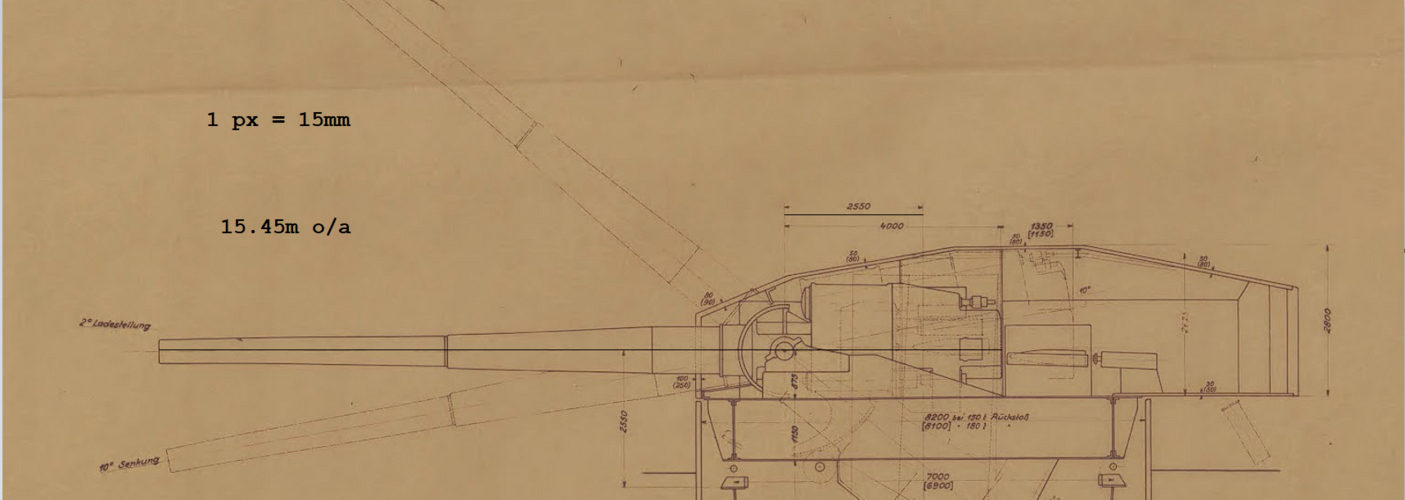
This image is of the "28cm/55 C/27Lc2 (Elevator Hoist)". It appears t have a 15.45m overall gun length. Divided by 283mm you get a caliber of 54.6. Divided by 305mm you get a caliber of 50.65.
It had come to my attention a while ago that the 30.5cm guns intended for Zenker's battlecruiser design were to be of /55-caliber length.
I believe that the first image - the C/26La - is actually either the 305mm gun used for Zenker's battlecruiser or a slightly earlier predecessor. Given the shapes...I might be forced to go with the latter conclusion.
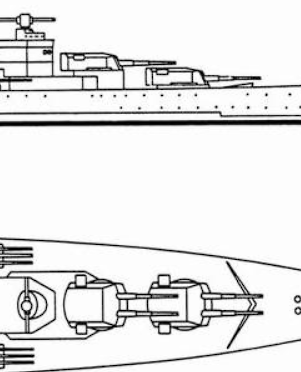
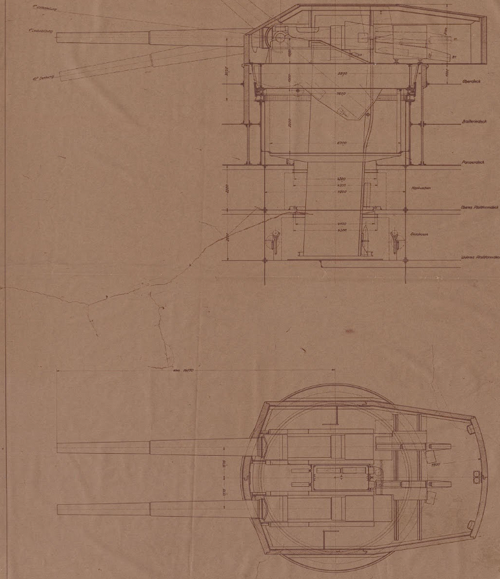
Close, but not the same.
I still maintain that it's a 305mm gun based on measurements, but what are y'all's thoughts on it?
Edit: No, it's not for Entwurf II/30 and VII/30, those turrets are of a much older design, it appears. (Very WWI 30.5cm SK L/50-esque)
Last edited:
_Sarcasticat_
Die Katze.
- Joined
- 16 April 2020
- Messages
- 364
- Reaction score
- 351
That seems really odd. Breyer has the most information out of any source regarding the design, so it would only make sense that he has a sketch of the original design? If anyone would have the original design/sketch, chances are it would be him.Is that drawing from Breyer? He might not had access to the turret drawings but rather a sketch of the BC and made his own extrapolation. Same happenned with his Japanese No.13 drawing.
Always a possibility.Those turrets are likely intended for B1, B2 and C panzerschiffs, Zenker latter works, panzerschiff A i posted previously have similar gun-house shape like C/27 model.
Triple turret 20.3 plan in 1931, which has been digitalized, looks like C/25 turret on steroid.
Last edited:
_Sarcasticat_
Die Katze.
- Joined
- 16 April 2020
- Messages
- 364
- Reaction score
- 351
Triple turret 20.3 plan in 1931, which has been digitalized, looks like C/25 turret on steroid.
That 203mm triple looks amazing. Wish we had such detaiĺ for the 1938 Krupp version.Easy to miss it because long wall of texts.Looking for KW-45 and KW-50 but can't find it. Can you provide a direct link?
KW30 is probably something akin to O-class, though it leaves me wondering if KW30 and O class are more similar than just sharing a theoretically similar Displacement. I'm starting to believe that KW30 evolved into the O-class and KW45 and KW50 are the overarching successors (O40/41/42 being the internal successor designs) or alternative designs.
Hi All,
Was shown these supposed Quad 380/406 turrets from the Bundesarchive but I'm not sure if these are real/are in fact 380/406 and not just the ones designed for the Hybrid Carriers.
https://cdn.discordapp.com/attachments/515583624083406848/828527252877869106/RM375.png
https://cdn.discordapp.com/attachments/534621810306580500/1030489656246153226/unknown.png
https://cdn.discordapp.com/attachments/534621810306580500/1030489454588199013/unknown.png
Was shown these supposed Quad 380/406 turrets from the Bundesarchive but I'm not sure if these are real/are in fact 380/406 and not just the ones designed for the Hybrid Carriers.
https://cdn.discordapp.com/attachments/515583624083406848/828527252877869106/RM375.png
https://cdn.discordapp.com/attachments/534621810306580500/1030489656246153226/unknown.png
https://cdn.discordapp.com/attachments/534621810306580500/1030489454588199013/unknown.png
Already posted here before, these are 16" inch turret designed in 1938 by Krupp.Hi All,
Was shown these supposed Quad 380/406 turrets from the Bundesarchive but I'm not sure if these are real/are in fact 380/406 and not just the ones designed for the Hybrid Carriers.
https://cdn.discordapp.com/attachments/515583624083406848/828527252877869106/RM375.png
https://cdn.discordapp.com/attachments/534621810306580500/1030489656246153226/unknown.png
https://cdn.discordapp.com/attachments/534621810306580500/1030489454588199013/unknown.png

Speaking of, here's 28.3cm turret named "P turret", almost identical to C/34 turret except slope sides turret face, three stacked ammunition cages on main hoists and the gun breech have some kind of locks (possibly a screw-breech gun?) since other turret sketches doesn't have it.
Date of design: 7/6/1939.
Last edited:
_Sarcasticat_
Die Katze.
- Joined
- 16 April 2020
- Messages
- 364
- Reaction score
- 351
ceccherini
In war there is no substitute for victory
- Joined
- 26 February 2015
- Messages
- 160
- Reaction score
- 190
The Graf Zeppelin at some stage in its design process was intended to have 3 such turrets. It's the only purpose I can think of, besides export to the Soviet Union, because KM basically abandoned the heavy cruiser concept after the Hipper class.What was the triple 203mm turret designed for (are there any projects it would have been used on)?
- Joined
- 1 February 2011
- Messages
- 2,933
- Reaction score
- 3,611
Check the thread's previous pagesDoes anybody have blueprints of 406mm SK C/34 L52 gun in turret?
_Sarcasticat_
Die Katze.
- Joined
- 16 April 2020
- Messages
- 364
- Reaction score
- 351
I just wanted to share this bit of interesting information with the rest of you since I had it pop up in recent conversation with one of my other naval circles.
The Breyer Proposal

What we're looking at here is a page coming from the 1970 first-print copy of Siegfried Breyer's Battleships and Battle Cruisers 1905-1970. What we're looking at specifically here is Gneisenau, "Modification Project 1942/43, made according to official records". Note the use of the word "records". This does not say "plans", "images", "sketches", or any other form of drawing, but written records.
So...what is so special about this drawing of Gneisenau?
What makes this particular rendition of Gneisenau's 38cm rebuild so interesting is that it takes a stab at depicting the short-lived plan to provide a unified (single-caliber) Dual-Purpose secondary battery for the ship, replacing the split 15cm/10.5cm secondary gun battery. This is perhaps the earliest attempt at doing so and provides a unique, if incorrect, depiction.
Unified-caliber dual-purpose secondary batteries had gained some amount of traction as early as the late 1930's, as far as I can tell, with the planned Deutschland rebuilds. This rebuild, planned for all three Deutschland-class ships, called for dual-purpose 128mm guns to replace the 15cm/55 singles and 10.5cm twins (the type and number of these 128mm guns is unknown***). More concretely, in 1941 there was also the suggestion of a unified 128mm DP secondary battery for H41 in place of her standard secondary battery (6x2 15cm/8x2 10.5cm). Again, number and type are unknown. This can be found in RM6 if you want to go searching for it.
And, of course, we have the somewhat well-known Gneisenau conversion to 128mm DP guns plan.
For Breyer's interpretation, he has decided to use the 128mm/45 SK C/41 in Drhl C/41 twin turret, developed and prototyped in 1941, therefore replacing the 15cm/55 and 10.5cm twin turrets on a 1-for-1 basis for 11 turrets total. He also took the liberty of upgrading the AA and adding a small tactical radar on the tripod mast aft of the smokestack.
The issue with Breyer's depiction is that he appears to have had very little information to work with - likely just the caliber and number of guns - or in the case of the secondary battery, just caliber - leading to the necessity of making his own version of the project based on the written information he had. You can tell by the out-of-standard placement of the 2cm singles, the fact the tripod mast has no been moved aft (to match Scharnhorst), or even the use of the 128mm SK C/41. If you do not believe me, then by his own admission in the 1978 reprint of the book featuring numerous corrections and alterations, one of which is the removal of the old Gneisenau image above with the one below, as well as the following words:

"[In terms of upgrading only so far as the 38cm guns and 2cm AA] ...Any information to the contrary concerning the conversion of Gneisenau has not stood up to more recent rechecking and is therefore incorrect."
A strange way of admitting you fucked up and made a fictional fan-drawing, but sure enough this drawing does depict design K235/N4 for Gneisenau, created in 1942 and nowadays given the archive code of RM 25/15788:
While it may be true that K235/N4 does not feature an altered secondary battery, that is not all there is to the story. In fact, there was actually a plan to replace the secondary battery with DP 128s. Garzke and Dulin's Axis and Neutral Battleships of World War II (not the best authors or most accurate book by any means, but still a generally good source) references this, stating the intention of the study was to source "recently developed" "127mm guns"* (this can reasonably be assumed to only mean the 128mm/61 Flak 40, as it entered production in mid/late 1941, and not the 128mm/45 SK C/41 as the latter would not face the issue of being claimed by other branches on grounds of priority, mainly because it is a weapon developed specifically for naval service) for use on Gneisenau, but the Heer and Luftwaffe claimed priority on the weapons - which were in very short supply, with only 1 being produced per month until mid-1944 - ending the idea almost as soon as it began.
In short, Breyer was incorrect yet again - and this, kids, is why you don't say anything with absolute certainty in a field where there is so much information yet to be released.
* = 12.7cm and 12.8cm were interchangeable in sources of the Wehrmacht, but actual bore diameter of most (if not all) German domestic production 5" caliber guns was 12.8cm.
Still, despite not having Flak 40 guns, to discredit the technical plausibility of the refit is wrong. Why is that? Let's discuss, but first: a developmental history of the gun in question:
"A Short Developmental History of the SK C/41 with Statistics":
In 1941 (thus proving that the KM was aware of and wanting the Flak 40 before 1942), a Flakzwilling 40 (Flakzwilling 40/2 or 42, depending on source) was returned to Rheinmetall-Borsig A.G. (the designer and producer of the Flak 40) so that the barrels could be changed out for shorter 45-caliber models capable of firing the 128mm/45 SK C/34's naval ammunition for use in turrets based on the Drhl C/38 twin. By the end of testing, the barrels had been shortened by just 30mm, the rifling to changed (to 1.7mm x 5.05mm versus 1.5mm x 6.0mm [SK C/34] and 1.7mm x 6.55mm [Flak 40]), and the mount lightened and decreased in size (most notably the guns placed much closer together for use in the new turret that was also designed in parallel with the gun: the Drhl C/41 twin). It is this gun that would be the 128mm/45 SK C/41.
The 128mm/45 SK C/41 is a semi-automatic, manually operated horizontal sliding wedge design with a lined barrel of 40 grooves (same as Flak 40) 1.7mm deep and 5.05mm wide. The gun is fired by an electromagnetic method with a backup mechanical firing system, features a brake hydraulic recoil cylinder + pneumatic knurler, and is loaded by an electric rammer. Horizontal and vertical guidance was also electrical. Also attached to the mount was a fuze-setting device. Most of these features are shared with the Flak 40.
Each gun weighed 4250kg, had an o/a length (includes breech) of 5807mm, barrel body length of 5400mm, and a rifling length of 4547mm. Working pressure is 2950 kg/cm2.
The "technical" rate of fire for these guns is 18 RPM per gun. In field tests with the Flakzwilling 40, rates of fire from a trained crew reached as high as 28-30 RPM per mount (14-15 RPM per gun). This is all well and dandy, but everyone tends to conveniently ignore the other factors, such as the rate of supply, endurance and training of the loaders, and operating environment (which would not be friendly on a rolling and pitching small destroyer turret).
The rounds fired are those from the SK C/34, pressed into a different cartridge and do not match that fired by the Flak 40. The ammunition is unitary. The two rounds are:
The ammunition for the Flak 40 is as follows:
Both AA ammunition types are quite impressive, featuring good muzzle velocity (800+ m/s) and packing over 7 pounds of explosive filler, putting it's explosive weight on par with USN 5"/38 AAC rounds.
The Drhl. C/41 turrets are scaled down Drhl. C/38 twins and serve to lighten the turret both by making it smaller and reducing the armor to just 8mm (sides) - 10mm (face). On the Type 1936A/36A Mob ships, the armor for the Drhl. C/38 was 20mm (sides) - 30mm (face), however the weight reduction is apparent, going from 60.4t (occasionally 62t depending on source) to 40.5t. The guns were placed in a single cradle, and the reduction between the guns from 2325mm (Flak 40) to just 1500mm (C/41) caused a limited elevation of just 52 degrees - a downgrade from the Drhl. C/38's 62 degrees. Additional problems may be faced as the Drhl. C/38 faced issues with keeping water out of the turret, which had caused electrical shorts and faults. The addition of more electronics (such as the rammer) may exacerbate this issue if the mount is not sufficiently weatherproofed.
/end
With the 128mm/45 SK C/41 theoretically ready for tooling and then full production by 1942, it only became an issue with where to put the newly designed weapons. Of course, almost all new destroyer designs from 1941 and onwards would feature the new turret - it was designed for them, after all - but, as most know, only 2 of the designs that would feature it were ever even laid down, and nearly at war's end to boot, ensuring that demand for the production of the system remained low. The same issue was faced with the Drhl. C/38 for the 15cm/48 TK C/36, in design since 1937 (and presumably first constructed in 1938, hence "C/38") it did not reach service until 1942 as most of the designs that might have included it were cancelled (due to the outbreak of the war or in favor of another class) until the refits of the 1936A and the laying down of the Type 1936A (Mob) types.
Of course, that never stopped naval architects from drawing and designing, and with her planned rebuild in 1942-43, Gneisenu is in the perfect position to get the Drhl. C/41. Being essentially a Kriegsmarine-tailored Flakzwilling 40, the KM could now, basically, get the Flakzwilling 40 for their own "domestic" ends without having to fight the Heer and Luftwaffe (both much higher priority branches) for it.
But after this, it sort-of falls apart.
While there are a few Pros to this sort of idea (The ability to fit 16.66 [16] C/41 twins for the same weight as Gneisenau's original secondary battery, the AA-capable performance of all mounts, powered loading, a fully enclosed turret, etc) the cons come to bite much harder:


The P.1000 Ratte mockup as of October 1942, clearly showing the SK C/41 in Drhl. C/41.
In conclusion: There are better alternatives. The 128mm/45 SK C/41 and its turret are good in a pinch if it was the only option available, but there would have to be a concerted effort to get production rolling and an acceptance that, in a combat situation, these turrets are highly vulnerable and may not perform as expected.
Speaking of alternatives.
Most even slightly familiar with Kriegsmarine design will more than likely at least be aware of WarGaming's tier 7 battleship Gneisenau from World of Warships, so, while we're here, why not discuss that too?
The WarGaming Model
Gneisenau in WoWs, represented by the "B" hull, features 11* Drhl. C/38 twin turrets. These turrets, designed for the larger 15cm/48 TK C/36, have been re-armed with the 128mm/61 "KM40" (Flakzwilling 40). In addition to the alterations to the secondary battery, WG have also re-arranged the superstructure and enhanced the AA in their typical way (that is, to say, badly).
In spite of that, the concept of WarGaming's Gneisenau secondary battery refit model is actually much better than what your typical elitist would give it credit for, the very same who would scoff at even the thought that a WG creation might have been decent - and to be honest, it's not entirely undeserved, but this is one of those exceptions.
...Wait, what are you doing with that pitchfork and torch? Wait, I'm sorry! Put it down! I'll apologi- screaming
* = Gneisenau could accommodate a maximum of 14.7 (15) 128mm/61 KM40 in Drhl. C/38 turrets for approximately the same total weight as the 15cm and 10.5cm turrets they replace.
So why is this WarGaming version of the Gneisenau 128 DP secondary battery "good"? This design matches the assumed gun type and thus meets the most basic criteria, automatically putting it ahead of the Breyer Proposal, but before we get to the core reasons why, let's discuss the Pros and Cons of using this gun and turret combination:
Pros:

Cons:
As you can see, the Pros certainly outweigh the Cons, much more so than the 128mm SK C/41 used in the Breyer Proposal, and even the Cons are not things that cannot be overcome with some minor edits (with the exception of triaxial stability or the making of holes in the decks). Even if the weight savings obtained by using the KM40 over the 15cm/48 TK C/36 (Drhl. C/38 w/ KM40 = 52.87t vs 60.4t with 15cm/48) was eaten up entirely, one could still replace the entire secondary battery 1-for-1 and still only break even.
In conclusion: It is the perfect design for the Kriegsmarine in a pinch if they got their hands on the F.Z. 40 for Gneisenau, according to plan - "Kriegsmarine in a pinch" pretty much describing the KM ever since the war broke out. Out of all the turret and gun options, it is the most rapidly sourced among them, requiring only minor modification, already in production, and all-around well-suited for DPAA work as a secondary weapon compared to the 128mm SK C/41.
For the Kriegsmarine, it's all about what could be sourced quickly - there's a war on (or if 1938/39, would be very soon), and you have to use what you have, even if it isn't the best thing. Sometimes that begets creative and otherwise unorthodox solutions, but it generally will consist of things already in production. You will see this reflected in almost every German design from 1938 and on and is just part of the nature of the beast. So, as odd as it might sound, WG nailed their Gneisenau secondary battery refit on the head - and it looks good to boot.
But it's not the most optimal choice.
So what does the most "optimal" possible secondary refit look like? Here's my suggestion:
The Sarcasticat Proposal
A few of you probably already know where this is heading, but still, let's discuss.
So if the 12.8cm SK C/41 and Drhl. C/41 and the Drhl. C/38 turret are out of the picture for the F.Z. 40, what's left?
Well, during mid-to-late 1940 and early 1941 there was a series of high-elevation triaxial enclosed turret designs (read: big 10.5cm twin mount) for a "12.7cm Doppelflak L54". Upon closer inspection, it is obvious this is just a shorter 128mm Flakzwilling 40. Whether this is because the KM expected to shorten the 61-caliber barrel to reduce weight (most likely) or because at this time the length of the barrel has not been determined (less likely), it is still clear to see that, with the issue of production not forthcoming at the time, the KM figured that it would have access to a larger number of the 'intermediate caliber' weapons that underwent testing in 1938 and was nearing its final form in late 1940 and as such made a series of pre-emptive designs for twin turrets.
The name of these designs is unknown, but "LM40" is already taken, haven been given to the coastal mounts. Given the date of the final design we have being very early 1941, a prospective name might be "LM41". The guns had an elevation of +85 deg and could depress -10 deg, but other specifications (such as elevation/training speeds, weight, etc) are not known or were not created. However, one can guess that the weapon would be immensely weighty - upwards of 60t with train and elevation speeds somewhere in the ballpark of 10 deg/s. This is a design meant as a large secondary weapon.

The final rendition of the 12.7cm Doppelflak twin turret design, 22 January 1941. For those of you who find this turret familiar, you can find it on some high-tier German ships in WoWs (Preussen, Clausewitz, and Hannover, for example).
For Gneisenau this is about the best that would ever possibly be available - that we currently know of - and despite the unfavorable weight estimate the ship could still handle a 1-for-1 swap and break even with the original 15cm/10.5cm battery weight.
Let's discuss the Pros and Cons:
Pros:
As you can see there isn't a lot to write about because there isn't much that is known. In theory, if this is just an enlarged version of the 10.5cm with some additional features, one might expect to see similar levels of armor, comparable train and elevation rates (at least to the 10.5cm C/38 mount), and overall good performance - just at a larger scale. The main issue comes with production, but at least the design dates to 1940 (or latest known, Jan. 1941) which means that it has at least reached paper in a detailed form even if no prototype turrets were made (to our knowledge). However, there is no getting around this production issue (prototyping, tooling, etc) unless the turret has priority and it is certain the KM can attain the F.Z. 40 to mount to it, leaving this proposal dead last in terms of production potential - even the 128mm SK C/41 is slightly ahead due to finalized turret design, mount prototype, the like.
In conclusion: It's the most optimal and reasonable turret for the job, it just needs to get produced. But for 1942-going-on-43 Germany, that's quite a tall order, even if it was as simple as "make 10.5cm - but bigger".
Conclusion.
Some people on the internet say that the Drhl. C/38 turret is intended to be the stopgap measure until the triaxial mount ("LM40") (or perhaps LM44) could be produced, which, regardless of truth, makes the most sense when you think about it. In 1943 the C/38 is the only available HA turret or mount of any type that the Kriegsmarine has in production that could take the 12.8cm F.Z. 40/KM40 if they were to receive a batch that year. With the war tipping out of their favor and the disastrous Battle of the Barents Sea (31 Dec 1942) causing Hitler to call for a complete removal of all his capital ships (from existence), it suddenly becomes that much harder to substantiate the worth of getting such a complex turret as the "LM41"/LM44 on short notice. This is probably why only design work was underway when the war ended.
So in short that leaves us with this conclusion: The "LM41" is the most optimal turret, the C/38 is the most realistic and practical, and the SK C/41 is the choice the KM would make if they couldn't get their hands on the Flakzwilling 40 but still wanted to proceed with a secondary battery change.
But I guess K235/N4 trumps all of them because it's the only drawing we have on paper.
Well, maybe there are more drawings of proposed secondary battery changes, or more discussions in books somewhere, but we don't have those yet. Maybe one day.
Whew, another full day taken to revise this! Hope someone learned something.
The Breyer Proposal
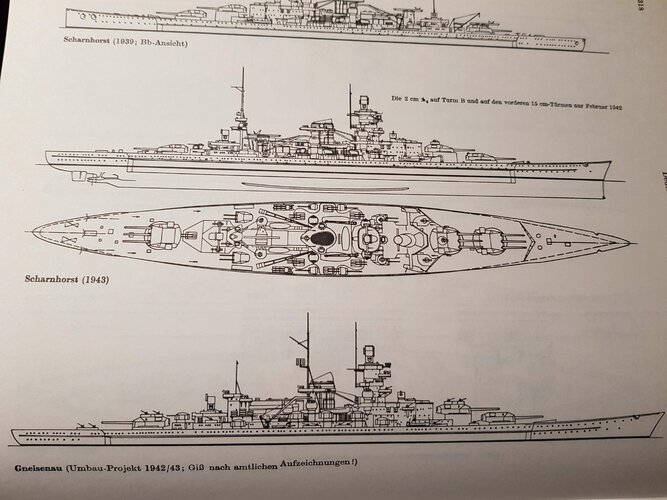
What we're looking at here is a page coming from the 1970 first-print copy of Siegfried Breyer's Battleships and Battle Cruisers 1905-1970. What we're looking at specifically here is Gneisenau, "Modification Project 1942/43, made according to official records". Note the use of the word "records". This does not say "plans", "images", "sketches", or any other form of drawing, but written records.
So...what is so special about this drawing of Gneisenau?
What makes this particular rendition of Gneisenau's 38cm rebuild so interesting is that it takes a stab at depicting the short-lived plan to provide a unified (single-caliber) Dual-Purpose secondary battery for the ship, replacing the split 15cm/10.5cm secondary gun battery. This is perhaps the earliest attempt at doing so and provides a unique, if incorrect, depiction.
Unified-caliber dual-purpose secondary batteries had gained some amount of traction as early as the late 1930's, as far as I can tell, with the planned Deutschland rebuilds. This rebuild, planned for all three Deutschland-class ships, called for dual-purpose 128mm guns to replace the 15cm/55 singles and 10.5cm twins (the type and number of these 128mm guns is unknown***). More concretely, in 1941 there was also the suggestion of a unified 128mm DP secondary battery for H41 in place of her standard secondary battery (6x2 15cm/8x2 10.5cm). Again, number and type are unknown. This can be found in RM6 if you want to go searching for it.
And, of course, we have the somewhat well-known Gneisenau conversion to 128mm DP guns plan.
* = Given the year of the planned rebuilds, the Drhl. C/38 turret - the shape, size, weight, and other dimensions completed by the time of the rebuild proposals - is the most likely choice for this (even if weight savings were not as high as expected). By the calculations I made you could get 5.5 (limited to 5 in reality) regularly armored (30mm face, 20mm sides) Drhl. C/38 twin turrets with 12.8cm/45 SK C/34 guns. These turrets would most likely be placed 2 to a side with one centerline aft, replacing the 10.5cm gun there. If this was done, there would have been a weight savings of 29.5 tonnes. If you were to de-armor the turrets for approximately 42-43t, you could get 6.6 turrets (6 with weight savings, 7 with a slight weight penalty) (3 to a side or 3 to a side with one centerline aft). Alternative armor arrangements for the turret have been considered before, the particular example in mind being the O-class (14mm), and of course the smooth-ified Drhl. C/38 for submarines is likely unarmored given the weight (42.2t). A small weight penalty could be allowed for as the ships were expected to increase upwards of 700t in their rebuilds.
For Breyer's interpretation, he has decided to use the 128mm/45 SK C/41 in Drhl C/41 twin turret, developed and prototyped in 1941, therefore replacing the 15cm/55 and 10.5cm twin turrets on a 1-for-1 basis for 11 turrets total. He also took the liberty of upgrading the AA and adding a small tactical radar on the tripod mast aft of the smokestack.
The issue with Breyer's depiction is that he appears to have had very little information to work with - likely just the caliber and number of guns - or in the case of the secondary battery, just caliber - leading to the necessity of making his own version of the project based on the written information he had. You can tell by the out-of-standard placement of the 2cm singles, the fact the tripod mast has no been moved aft (to match Scharnhorst), or even the use of the 128mm SK C/41. If you do not believe me, then by his own admission in the 1978 reprint of the book featuring numerous corrections and alterations, one of which is the removal of the old Gneisenau image above with the one below, as well as the following words:
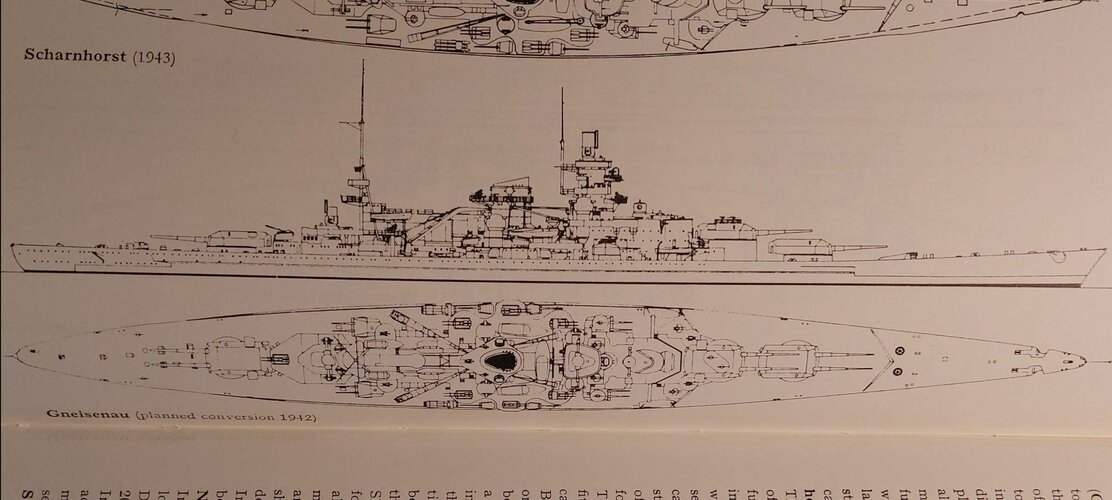
"[In terms of upgrading only so far as the 38cm guns and 2cm AA] ...Any information to the contrary concerning the conversion of Gneisenau has not stood up to more recent rechecking and is therefore incorrect."
A strange way of admitting you fucked up and made a fictional fan-drawing, but sure enough this drawing does depict design K235/N4 for Gneisenau, created in 1942 and nowadays given the archive code of RM 25/15788:
While it may be true that K235/N4 does not feature an altered secondary battery, that is not all there is to the story. In fact, there was actually a plan to replace the secondary battery with DP 128s. Garzke and Dulin's Axis and Neutral Battleships of World War II (not the best authors or most accurate book by any means, but still a generally good source) references this, stating the intention of the study was to source "recently developed" "127mm guns"* (this can reasonably be assumed to only mean the 128mm/61 Flak 40, as it entered production in mid/late 1941, and not the 128mm/45 SK C/41 as the latter would not face the issue of being claimed by other branches on grounds of priority, mainly because it is a weapon developed specifically for naval service) for use on Gneisenau, but the Heer and Luftwaffe claimed priority on the weapons - which were in very short supply, with only 1 being produced per month until mid-1944 - ending the idea almost as soon as it began.
In short, Breyer was incorrect yet again - and this, kids, is why you don't say anything with absolute certainty in a field where there is so much information yet to be released.
* = 12.7cm and 12.8cm were interchangeable in sources of the Wehrmacht, but actual bore diameter of most (if not all) German domestic production 5" caliber guns was 12.8cm.
Still, despite not having Flak 40 guns, to discredit the technical plausibility of the refit is wrong. Why is that? Let's discuss, but first: a developmental history of the gun in question:
"A Short Developmental History of the SK C/41 with Statistics":
In 1941 (thus proving that the KM was aware of and wanting the Flak 40 before 1942), a Flakzwilling 40 (Flakzwilling 40/2 or 42, depending on source) was returned to Rheinmetall-Borsig A.G. (the designer and producer of the Flak 40) so that the barrels could be changed out for shorter 45-caliber models capable of firing the 128mm/45 SK C/34's naval ammunition for use in turrets based on the Drhl C/38 twin. By the end of testing, the barrels had been shortened by just 30mm, the rifling to changed (to 1.7mm x 5.05mm versus 1.5mm x 6.0mm [SK C/34] and 1.7mm x 6.55mm [Flak 40]), and the mount lightened and decreased in size (most notably the guns placed much closer together for use in the new turret that was also designed in parallel with the gun: the Drhl C/41 twin). It is this gun that would be the 128mm/45 SK C/41.
The 128mm/45 SK C/41 is a semi-automatic, manually operated horizontal sliding wedge design with a lined barrel of 40 grooves (same as Flak 40) 1.7mm deep and 5.05mm wide. The gun is fired by an electromagnetic method with a backup mechanical firing system, features a brake hydraulic recoil cylinder + pneumatic knurler, and is loaded by an electric rammer. Horizontal and vertical guidance was also electrical. Also attached to the mount was a fuze-setting device. Most of these features are shared with the Flak 40.
Each gun weighed 4250kg, had an o/a length (includes breech) of 5807mm, barrel body length of 5400mm, and a rifling length of 4547mm. Working pressure is 2950 kg/cm2.
The "technical" rate of fire for these guns is 18 RPM per gun. In field tests with the Flakzwilling 40, rates of fire from a trained crew reached as high as 28-30 RPM per mount (14-15 RPM per gun). This is all well and dandy, but everyone tends to conveniently ignore the other factors, such as the rate of supply, endurance and training of the loaders, and operating environment (which would not be friendly on a rolling and pitching small destroyer turret).
The rounds fired are those from the SK C/34, pressed into a different cartridge and do not match that fired by the Flak 40. The ammunition is unitary. The two rounds are:
1. HE 12.7 cm Spgr. L/4,5 Kz (mHb) (Head fuse, ballistic fairing) [28 kg projectile, 49.0 kg o/a weight, 4.41 pounds/2.0 kg explosive filler, 10 kg RPC/40N propellant charge, 830 m/s MV, 22km range @ 40 degrees.]
2. HE (AA) 12.7 cm Spgr. L/4,5 Kz (mHb) (Time fuse) [28 kg projectile, 49.0 kg o/a weight, 7.05 pounds/3.2 kg explosive filler, 10 kg RPC/40N propellant charge, 830 m/s MV, unknown surface range, 12.2km vertical range at 70 degrees. 20-caliber projectile radius.]
3. Armor piercing ammunition was not supplied, though theoretically it could have been.
2. HE (AA) 12.7 cm Spgr. L/4,5 Kz (mHb) (Time fuse) [28 kg projectile, 49.0 kg o/a weight, 7.05 pounds/3.2 kg explosive filler, 10 kg RPC/40N propellant charge, 830 m/s MV, unknown surface range, 12.2km vertical range at 70 degrees. 20-caliber projectile radius.]
3. Armor piercing ammunition was not supplied, though theoretically it could have been.
The ammunition for the Flak 40 is as follows:
1. HE (AA) 12.8 cm Sprgr.Patr. L/4,5 (Time fuse) [26 kg projectile, 45.47 kg o/a weight, 7.47 pounds/3.39 kg explosive filler, 9.62 kg propellant charge, 880 m/s MV, 20.9km surface range, 14.8km vertical range.] Another source states a o/a weight of 47.4 kg for the round, 26 kg projectile, and 10.1kg of propellant charge.
Both AA ammunition types are quite impressive, featuring good muzzle velocity (800+ m/s) and packing over 7 pounds of explosive filler, putting it's explosive weight on par with USN 5"/38 AAC rounds.
The Drhl. C/41 turrets are scaled down Drhl. C/38 twins and serve to lighten the turret both by making it smaller and reducing the armor to just 8mm (sides) - 10mm (face). On the Type 1936A/36A Mob ships, the armor for the Drhl. C/38 was 20mm (sides) - 30mm (face), however the weight reduction is apparent, going from 60.4t (occasionally 62t depending on source) to 40.5t. The guns were placed in a single cradle, and the reduction between the guns from 2325mm (Flak 40) to just 1500mm (C/41) caused a limited elevation of just 52 degrees - a downgrade from the Drhl. C/38's 62 degrees. Additional problems may be faced as the Drhl. C/38 faced issues with keeping water out of the turret, which had caused electrical shorts and faults. The addition of more electronics (such as the rammer) may exacerbate this issue if the mount is not sufficiently weatherproofed.
/end
With the 128mm/45 SK C/41 theoretically ready for tooling and then full production by 1942, it only became an issue with where to put the newly designed weapons. Of course, almost all new destroyer designs from 1941 and onwards would feature the new turret - it was designed for them, after all - but, as most know, only 2 of the designs that would feature it were ever even laid down, and nearly at war's end to boot, ensuring that demand for the production of the system remained low. The same issue was faced with the Drhl. C/38 for the 15cm/48 TK C/36, in design since 1937 (and presumably first constructed in 1938, hence "C/38") it did not reach service until 1942 as most of the designs that might have included it were cancelled (due to the outbreak of the war or in favor of another class) until the refits of the 1936A and the laying down of the Type 1936A (Mob) types.
Of course, that never stopped naval architects from drawing and designing, and with her planned rebuild in 1942-43, Gneisenu is in the perfect position to get the Drhl. C/41. Being essentially a Kriegsmarine-tailored Flakzwilling 40, the KM could now, basically, get the Flakzwilling 40 for their own "domestic" ends without having to fight the Heer and Luftwaffe (both much higher priority branches) for it.
But after this, it sort-of falls apart.
While there are a few Pros to this sort of idea (The ability to fit 16.66 [16] C/41 twins for the same weight as Gneisenau's original secondary battery, the AA-capable performance of all mounts, powered loading, a fully enclosed turret, etc) the cons come to bite much harder:
- The turrets are completely unarmored (8-10mm) and hardly what you would call splinterproof, making them highly vulnerable, nearly equally so to the 105mm/65.
- The turrets are small and cramped, reducing effective ROF and do not make better utilization of Gneisenau's deck space (by placing larger turrets to alleviate this) in a 1-for-1 swap.
- Maximum elevation is only 52 degrees.
- Training and elevation speed limited to 8.5 degrees/second (needs verification), too slow for a mount this light and of year of design.
- The turrets are not triaxial or (appear to be) RPC and would not make fully use of the RPC-capable triaxially stabilized SL-type directors.
- Although theoretically ready for production, production has not yet begun (or, it appears, even prepared for) as compared to the F.Z. 40.
- Possible additional weatherproofing problems by placing them at the weather deck level.
- Destroyers would have priority as it was a small turret with many concessions, designed for them specifically.


The P.1000 Ratte mockup as of October 1942, clearly showing the SK C/41 in Drhl. C/41.
In conclusion: There are better alternatives. The 128mm/45 SK C/41 and its turret are good in a pinch if it was the only option available, but there would have to be a concerted effort to get production rolling and an acceptance that, in a combat situation, these turrets are highly vulnerable and may not perform as expected.
Speaking of alternatives.
Most even slightly familiar with Kriegsmarine design will more than likely at least be aware of WarGaming's tier 7 battleship Gneisenau from World of Warships, so, while we're here, why not discuss that too?
The WarGaming Model
Gneisenau in WoWs, represented by the "B" hull, features 11* Drhl. C/38 twin turrets. These turrets, designed for the larger 15cm/48 TK C/36, have been re-armed with the 128mm/61 "KM40" (Flakzwilling 40). In addition to the alterations to the secondary battery, WG have also re-arranged the superstructure and enhanced the AA in their typical way (that is, to say, badly).
In spite of that, the concept of WarGaming's Gneisenau secondary battery refit model is actually much better than what your typical elitist would give it credit for, the very same who would scoff at even the thought that a WG creation might have been decent - and to be honest, it's not entirely undeserved, but this is one of those exceptions.
...Wait, what are you doing with that pitchfork and torch? Wait, I'm sorry! Put it down! I'll apologi- screaming
* = Gneisenau could accommodate a maximum of 14.7 (15) 128mm/61 KM40 in Drhl. C/38 turrets for approximately the same total weight as the 15cm and 10.5cm turrets they replace.
So why is this WarGaming version of the Gneisenau 128 DP secondary battery "good"? This design matches the assumed gun type and thus meets the most basic criteria, automatically putting it ahead of the Breyer Proposal, but before we get to the core reasons why, let's discuss the Pros and Cons of using this gun and turret combination:
Pros:
- Turrets at least have a small amount of armoring, enough to stop some small-caliber HE rounds (on the face plate) and splinters from larger caliber weapons (all areas). The armor values match that of the Konigsberg-class cruisers, and is much greater than that of, at least, the 10.5cm/65.
- Turrets are described as large and "roomy" even despite the large 15cm breeches occupying the interior. Even with the 61-caliber Flak 40 being slightly longer than the 15cm/48 (7.835 meters vs 7.165 meters overall) (25.7 ft vs 23.5 ft) the actual space taken up inside the turret would not be significantly more, if at all, even with the electric rammer attached. - and if it was, only longitudinally. An idea can be garnered by viewing this image of the 15cm in Drhl. C/38

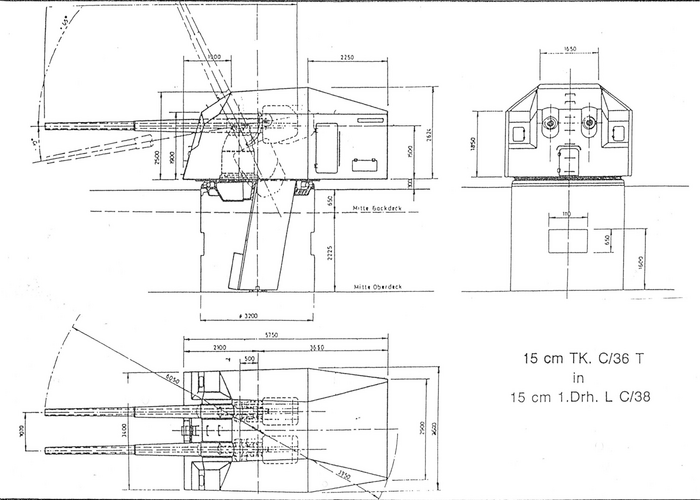
- Turrets are small enough to fit comfortably in large numbers, but not too small as to be uncomfortable to crew.
- Maximum elevation is 62 degrees. Not optimal, but adequate for AA use and an improvement over the SK C/41.
- Turrets have already entered service as of 1942 with construction of such mounts dating back to 1938.
- Existing turrets could be easily modified or turrets in production altered to better accept the 128mm/61 with no negative impact.
- Destroyers have returned to the 128mm SK C/34 or moved to the SK C/41, leaving this turret design without a priority.
- Turret is fully enclosed and largely protected from the weather.
- Powered loading is included.
- Superior ballistic performance (MV, range, etc) to other 128mm guns, and features a slightly larger bursting charge.
- The same turret was intended for use aboard the O-class battleships both at the weather deck level and a deck above.
- Training and elevation speeds are 8 degree/second, slow but equal to 10.5cm/65 C/37 mounts. This number may improve with the significantly lighter 128mm gun replacing the 15cm/48.
- A couple of (largely unsubstantiated) sources have stated it was the intention to move the 128mm/61 into this turret for testing, using guns placed around major port cities (such as Kiel).*
Cons:
- The turrets are not triaxial or (appear to be) RPC and would not make fully use of the RPC-capable triaxially stabilized SL-type directors. Perhaps the turret could be made with some amount of RPC, but that would take time and weight and would not make the guns any more triaxial.
- Possible weatherproofing problems by placing them at the weather deck level, especially bad on low-sitting ships such as the Scharnhorst-class. Weight removed by the use of 128mm will necessarily be eaten away at by additional weatherproofing.
- Ammunition supply rate is far too slow at just 8 rounds per minute per barrel, necessitating an improved ammunition elevator such as that of the Drhl. C/41 (15 rounds/minute/gun electric-driven) eating again away at saved weight and taking time.
As you can see, the Pros certainly outweigh the Cons, much more so than the 128mm SK C/41 used in the Breyer Proposal, and even the Cons are not things that cannot be overcome with some minor edits (with the exception of triaxial stability or the making of holes in the decks). Even if the weight savings obtained by using the KM40 over the 15cm/48 TK C/36 (Drhl. C/38 w/ KM40 = 52.87t vs 60.4t with 15cm/48) was eaten up entirely, one could still replace the entire secondary battery 1-for-1 and still only break even.
In conclusion: It is the perfect design for the Kriegsmarine in a pinch if they got their hands on the F.Z. 40 for Gneisenau, according to plan - "Kriegsmarine in a pinch" pretty much describing the KM ever since the war broke out. Out of all the turret and gun options, it is the most rapidly sourced among them, requiring only minor modification, already in production, and all-around well-suited for DPAA work as a secondary weapon compared to the 128mm SK C/41.
For the Kriegsmarine, it's all about what could be sourced quickly - there's a war on (or if 1938/39, would be very soon), and you have to use what you have, even if it isn't the best thing. Sometimes that begets creative and otherwise unorthodox solutions, but it generally will consist of things already in production. You will see this reflected in almost every German design from 1938 and on and is just part of the nature of the beast. So, as odd as it might sound, WG nailed their Gneisenau secondary battery refit on the head - and it looks good to boot.
But it's not the most optimal choice.
So what does the most "optimal" possible secondary refit look like? Here's my suggestion:
The Sarcasticat Proposal
A few of you probably already know where this is heading, but still, let's discuss.
So if the 12.8cm SK C/41 and Drhl. C/41 and the Drhl. C/38 turret are out of the picture for the F.Z. 40, what's left?
Well, during mid-to-late 1940 and early 1941 there was a series of high-elevation triaxial enclosed turret designs (read: big 10.5cm twin mount) for a "12.7cm Doppelflak L54". Upon closer inspection, it is obvious this is just a shorter 128mm Flakzwilling 40. Whether this is because the KM expected to shorten the 61-caliber barrel to reduce weight (most likely) or because at this time the length of the barrel has not been determined (less likely), it is still clear to see that, with the issue of production not forthcoming at the time, the KM figured that it would have access to a larger number of the 'intermediate caliber' weapons that underwent testing in 1938 and was nearing its final form in late 1940 and as such made a series of pre-emptive designs for twin turrets.
The name of these designs is unknown, but "LM40" is already taken, haven been given to the coastal mounts. Given the date of the final design we have being very early 1941, a prospective name might be "LM41". The guns had an elevation of +85 deg and could depress -10 deg, but other specifications (such as elevation/training speeds, weight, etc) are not known or were not created. However, one can guess that the weapon would be immensely weighty - upwards of 60t with train and elevation speeds somewhere in the ballpark of 10 deg/s. This is a design meant as a large secondary weapon.
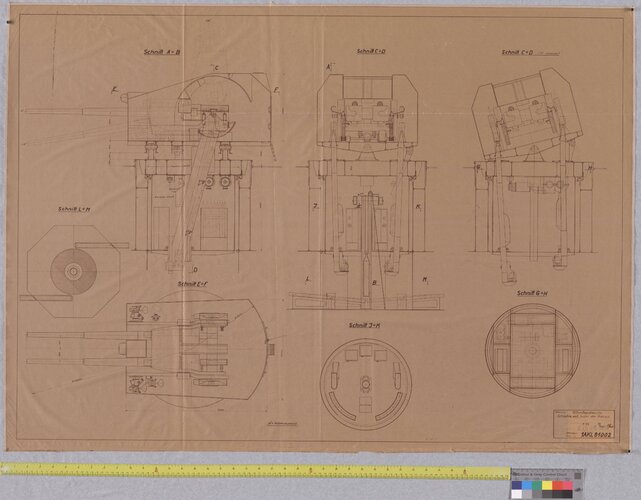
The final rendition of the 12.7cm Doppelflak twin turret design, 22 January 1941. For those of you who find this turret familiar, you can find it on some high-tier German ships in WoWs (Preussen, Clausewitz, and Hannover, for example).
For Gneisenau this is about the best that would ever possibly be available - that we currently know of - and despite the unfavorable weight estimate the ship could still handle a 1-for-1 swap and break even with the original 15cm/10.5cm battery weight.
Let's discuss the Pros and Cons:
Pros:
- Turret is slightly larger than the Drhl. C/38 (5.78m long x 3.4m wide for C/38 / 5.6m long x 4.0m wide for LM40)
- Maximum elevation is 85 degrees, perfect for AA work.
- Turret is fully enclosed and protected from the weather.
- Powered loading is included.
- Superior ballistic performance (MV, range, etc) to other 128mm guns, and features a slightly larger bursting charge.
- Gun is triaxial and no doubt will have RPC capabilities, making the most use of pre-existing SL directors.
- A lot of information is unknown, which makes it difficult to quantify how good or bad it truly is.
- Most likely of all turret options to suffer at weather deck level from waves and sea spray (corrosion, electrical faults, damage, etc).*
- Unsure if the design work has been completed, production is nowhere near beginning, and no prototypes exist, although it appears that there were efforts underway late in the war to get a turret like this, known as the 'Dopp Flak LM44', going.
- An extremely complex and delicate-looking mount which may take significant R&D time unless heavily prioritized.
As you can see there isn't a lot to write about because there isn't much that is known. In theory, if this is just an enlarged version of the 10.5cm with some additional features, one might expect to see similar levels of armor, comparable train and elevation rates (at least to the 10.5cm C/38 mount), and overall good performance - just at a larger scale. The main issue comes with production, but at least the design dates to 1940 (or latest known, Jan. 1941) which means that it has at least reached paper in a detailed form even if no prototype turrets were made (to our knowledge). However, there is no getting around this production issue (prototyping, tooling, etc) unless the turret has priority and it is certain the KM can attain the F.Z. 40 to mount to it, leaving this proposal dead last in terms of production potential - even the 128mm SK C/41 is slightly ahead due to finalized turret design, mount prototype, the like.
In conclusion: It's the most optimal and reasonable turret for the job, it just needs to get produced. But for 1942-going-on-43 Germany, that's quite a tall order, even if it was as simple as "make 10.5cm - but bigger".
Conclusion.
Some people on the internet say that the Drhl. C/38 turret is intended to be the stopgap measure until the triaxial mount ("LM40") (or perhaps LM44) could be produced, which, regardless of truth, makes the most sense when you think about it. In 1943 the C/38 is the only available HA turret or mount of any type that the Kriegsmarine has in production that could take the 12.8cm F.Z. 40/KM40 if they were to receive a batch that year. With the war tipping out of their favor and the disastrous Battle of the Barents Sea (31 Dec 1942) causing Hitler to call for a complete removal of all his capital ships (from existence), it suddenly becomes that much harder to substantiate the worth of getting such a complex turret as the "LM41"/LM44 on short notice. This is probably why only design work was underway when the war ended.
So in short that leaves us with this conclusion: The "LM41" is the most optimal turret, the C/38 is the most realistic and practical, and the SK C/41 is the choice the KM would make if they couldn't get their hands on the Flakzwilling 40 but still wanted to proceed with a secondary battery change.
But I guess K235/N4 trumps all of them because it's the only drawing we have on paper.
Well, maybe there are more drawings of proposed secondary battery changes, or more discussions in books somewhere, but we don't have those yet. Maybe one day.
Whew, another full day taken to revise this! Hope someone learned something.
Similar threads
-
Kaiserliche Marine - Imperial German Navy Ship Plans/Discussion
- Started by _Sarcasticat_
- Replies: 104
-
-
Kriegsmarine Naval What-If Ships
- Started by _Sarcasticat_
- Replies: 20
-
I-400 sized German U-boat projects from WW2?
- Started by Vahe Demirjian
- Replies: 9
-
Foreign Dockyards and Naval Bases (Unbuilt/Unrealised)
- Started by Pirate Pete
- Replies: 0


